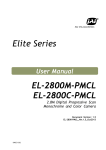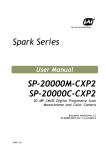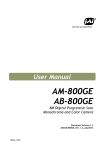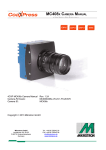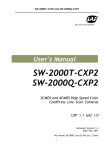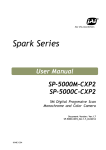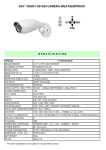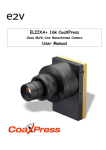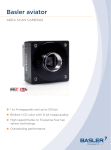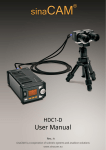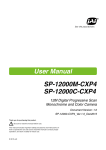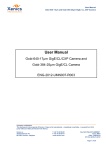Download Elite Series EL-2800M-CXP EL-2800C-CXP
Transcript
Elite Series
User Manual
EL-2800M-CXP
EL-2800C-CXP
2.8M Digital Progressive Scan
Monochrome and Color Camera
Document Version:1.4
EL-2800-CXP_Ver.1.4_Mar2014
1048E-1305
EL-2800M-CXP / EL-2800C-CXP
Notice
The material contained in this manual consists of information that is proprietary to JAI Ltd., Japan
and may only be used by the purchasers of the product. JAI Ltd., Japan makes no warranty for the
use of its product and assumes no responsibility for any errors which may appear or for damages
resulting from the use of the information contained herein. JAI Ltd., Japan reserves the right to
make changes without notice.
Company and product names mentioned in this manual are trademarks or registered trademarks of
their respective owners.
Warranty
For information about the warranty, please contact your factory representative.
Certifications
CE compliance
As defined by the Directive 2004/108/EC of the European Parliament and of the Council, EMC
(Electromagnetic compatibility), JAI Ltd., Japan declares that EL-2800M-CXP and EL-2800C-CXP
comply with the following provisions applying to its standards.
EN 61000-6-3 (Generic emission standard part 1)
EN 61000-6-2 (Generic immunity standard part 1)
FCC
This equipment has been tested and found to comply with the limits for a Class B digital device,
pursuant to Part 15 of the FCC Rules. These limits are designed to provide reasonable protection
against harmful interference in a residential installation. This equipment generates, uses and can
radiate radio frequency energy and, if not installed and used in accordance with the instructions,
may cause harmful interference to radio communications. However, there is no guarantee that
interference will not occur in a particular installation. If this equipment does cause harmful
interference to radio or television reception, which can be determined by turning the equipment
off and on, the user is encouraged to try to correct the interference by one or more of the following
measures:
- Reorient or relocate the receiving antenna.
- Increase the separation between the equipment and receiver.
- Connect the equipment into an outlet on a circuit different from that to which the receiver is
connected.
- Consult the dealer or an experienced radio/TV technician for help.
Warning
Changes or modifications to this unit not expressly approved by the party
responsible for FCC compliance could void the user’s authority to operate the
equipment.
-2-
EL-2800M-CXP
Supplement
The following statement is related to the regulation on “ Measures for the Administration
of the control of Pollution by Electronic Information Products “ , known as “ China RoHS “.
The table shows contained Hazardous Substances in this camera.
mark shows that the environment-friendly use period of contained Hazardous
Substances is 15 years.
嶷勣廣吭並㍻
嗤蕎嗤墾麗嵎賜圷殆兆各式根楚燕
功象嶄鯖繁酎慌才忽佚連恢匍何〆窮徨佚連恢瞳麟半陣崙砿尖一隈〇云恢瞳ゞ 嗤蕎嗤
墾麗嵎賜圷殆兆各式根楚燕 〃泌和
桟隠聞喘豚㍉
窮徨佚連恢瞳嶄根嗤議嗤蕎嗤墾麗嵎賜圷殆壓屎械聞喘議訳周和音氏窟伏翌
亶賜融延、窮徨佚連恢瞳喘薩聞喘乎窮徨佚連恢瞳音氏斤桟廠夛撹冢嶷麟半
賜斤児繁附、夏恢夛撹冢嶷鱒墾議豚㍉。
方忖仝15々葎豚㍉15定。
EL-2800C-CXP
Supplement
The following statement is related to the regulation on “ Measures for the Administration
of the control of Pollution by Electronic Information Products “ , known as “ China RoHS “.
The table shows contained Hazardous Substances in this camera.
mark shows that the environment-friendly use period of contained Hazardous
Substances is 15 years.
嶷勣廣吭並㍻
嗤蕎嗤墾麗嵎賜圷殆兆各式根楚燕
功象嶄鯖繁酎慌才忽佚連恢匍何〆窮徨佚連恢瞳麟半陣崙砿尖一隈〇云恢瞳ゞ 嗤蕎嗤
墾麗嵎賜圷殆兆各式根楚燕 〃泌和
桟隠聞喘豚㍉
窮徨佚連恢瞳嶄根嗤議嗤蕎嗤墾麗嵎賜圷殆壓屎械聞喘議訳周和音氏窟伏翌
亶賜融延、窮徨佚連恢瞳喘薩聞喘乎窮徨佚連恢瞳音氏斤桟廠夛撹冢嶷麟半
賜斤児繁附、夏恢夛撹冢嶷鱒墾議豚㍉。
方忖仝15々葎豚㍉15定。
EL-2800M-CXP / EL-2800C-CXP
- Contents Introduction ....................................................................................1. General ....................................................................................2.
Camera composition ...................................................................3.
Main features ............................................................................4.
Locations and functions ...............................................................4.1
4.2
6
7
7
8
9
-
Locations and functions ............................................................................- 9 Rear panel .......................................................................................... - 10 -
5. Input and output ......................................................................... - 11 5.1 CoaXPress interface standard.................................................................... 5.2 Connectors and pin assignment ................................................................. 5.2.1 Digital Video Output (75Ω 1.0/2.3 DIN Receptacle) .................................. 5.2.2 12-Pin connector.............................................................................. 5.2.2.1 Pin assignment ........................................................................... 5.2.3 AUX Standard Hirose 10-Pin connector for Lens ......................................... 5.2.4 AUX Type 2 HIROSE 10-Pin connector (Factory option).............................. 5.2.5 AUX Type 3 HIROSE 10-Pin connector (Factory option).............................. 5.3 Output ............................................................................................... 5.3.1 Digital output ................................................................................. 5.3.1.1 Output level .............................................................................. 5.4 Digital IN/OUT interface ......................................................................... 5.4.1 Line Selector .................................................................................. 5.4.2 Line source .................................................................................... 5.4.3 Line Mode ...................................................................................... 5.4.4 Line Inverter .................................................................................. 5.4.5 Line Status ..................................................................................... 5.4.6 Line Format ................................................................................... 5.4.7 GPIO ............................................................................................ 5.4.7.1 GPIO block diagram ..................................................................... 5.4.7.2
IN and OUT matrix table .............................................................. 5.5 Pulse Generator .................................................................................... 5.5.1 Clock Pre-scaler .............................................................................. 5.5.2 Pulse Generator Selector.................................................................... 5.5.3 Pulse Generator Length ..................................................................... 5.5.4 Pulse Generator Start Point ................................................................. 5.5.5 Pulse Generator End Point .................................................................. 5.5.6 Pulse Generator Repeat Count ............................................................. 5.5.7 Pulse Generator Clear Activation .......................................................... 5.5.8 Pulse Generator Clear Sync Mode .......................................................... 5.5.9 Pulse Generator Clear Source .............................................................. 5.5.10 Pulse Generator Inverter .................................................................. 5.5.11 Pulse Generator Setting table ............................................................ -
6.
11
12
12
12
12
12
13
13
14
14
14
14
14
15
15
15
15
15
15
16
17
18
18
18
19
19
19
19
19
19
21
22
22
-
Sensor layout, output format and timing ........................................ - 23 -
6.1 Sensor layout ....................................................................................... 6.1.1 Monochrome sensor .......................................................................... 6.1.2
Bayer color sensor .......................................................................... 6.2. Sensor readout (Sensor Tap Geometry) ....................................................... 6.2.1 4 taps readout (1X2–2YE) .................................................................... 6.2.2 2 Taps readout (2XE–1Y) ..................................................................... 6.2.3 1 tap readout (1X–1Y) ........................................................................ 6.3. Camera output format and sensor readout system ......................................... -
-3-
23
23
23
24
24
24
24
25
-
EL-2800M-CXP / EL-2800C-CXP
6.3.1 1X-1Y ...........................................................................................
6.3.2 1X–2YE .........................................................................................
6.4 The relations between tap Geometry and Frame rate ......................................
6.5 Output timing ......................................................................................
6.5.1 Horizontal timing.............................................................................
6.5.1.1 Output format 1X–2YE (Pixel clock: 108 MHz) ...................................
6.5.1.2 Output format 1X–2YE (Pixel clock: 108 MHz) ...................................
6.5.2.1 Output format 1X–1Y (Camera Output Pixel clock: 108 MHz) .................
6.5.2.2 Output format 1X–1Y (Camera Output Pixel clock: 108 MHz) .................
6.5.2 Vertical timing ................................................................................
6.5.2.1 Output format 1X–2YE Vertical binning OFF ..................................
6.5.2.2 Output format 1X–2YE Vertical binning ON .................................
6.5.2.3 Output format 1X–1Y Vertical Binning OFF ...................................
6.5.2.4 Output format 1X–1Y Vertical Binning ON ....................................
7.
25
25
26
26
26
26
27
27
27
28
28
28
28
28
-
Operating modes ...................................................................... - 29 -
7.1. Acquisition control (change the frame rate) .................................................
7.1.1 Acqusition mode..............................................................................
7.1.1.1 Single Frame .............................................................................
7.1.1.2 MultiFrame ...............................................................................
7.1.1.3 Continuous mode........................................................................
7.1.2 Acquisition frame count.....................................................................
7.1.3 Acquisition frame rate ......................................................................
7.1.4 Calculation of frame rate ...................................................................
7.1.4.1 V Binning Off .............................................................................
7.1.4.2 V Binning On .............................................................................
7.2. Exposure setting ..................................................................................
7.2.1 Exposure Mode ................................................................................
7.2.2 Exposure Time ................................................................................
7.2.3 Exposure Auto.................................................................................
7.3. Trigger Mode ......................................................................................
7.3.1 Trigger Source ................................................................................
7.3.2 Trigger activation ............................................................................
7.3.3 Trigger Overlap ...............................................................................
7.3.4 Trigger Delay ..................................................................................
7.4. Normal continuous operation (Timed Exposure Mode/Trigger Mode OFF)...............
7.5. Timed mode (EPS) ................................................................................
7.5.1 If the overlap setting is “OFF” .............................................................
7.5.2 If the overlap setting is “Readout” ........................................................
7.6. Trigger width mode ..............................................................................
7.6.1 If the overlap setting is “OFF” .............................................................
7.6.2 If the overlap setting is “Readout” ........................................................
7.7. RCT mode ..........................................................................................
7.8. PIV (Particle Image Velocimetry) ..............................................................
7.9. Sequential Timed Exposure Mode ..............................................................
7.9.1 Video send mode .............................................................................
7.9.2 Sequence ROI setting parameters .........................................................
7.10. Operation and function matrix ...............................................................
8.
-
29
29
29
33
37
39
40
40
40
40
41
41
41
42
42
42
42
42
43
43
43
44
44
45
45
46
47
48
49
49
50
52
-
Other functions ....................................................................... - 53 -
8.1 Black level control ................................................................................
8.1.1 Black Level Selector .........................................................................
8.1.2 Black Level ....................................................................................
8.1.3 Black Level Auto ..............................................................................
8.2 Gain control ........................................................................................
-4-
-
53
53
53
53
54
-
EL-2800M-CXP / EL-2800C-CXP
8.2.1 Gain Selector .................................................................................. 8.2.2 Gain............................................................................................. 8.2.3 Gain Raw ....................................................................................... 8.2.4 Gain Auto ...................................................................................... 8.2.5 Balance White Auto .......................................................................... 8.3. LUT.................................................................................................. 8.3.1 LUT Enable .................................................................................... 8.3.2 LUT Index ...................................................................................... 8.3.3 LUT value ...................................................................................... 8.4. Gamma ............................................................................................. 8.5. Shading Correction ............................................................................... 8.6. Blemish compensation ........................................................................... 8.7. Bayer color interpolation (Only for EL-2800C) ............................................... 8.8 Lens .................................................................................................. 8.8.1 About P-Iris .................................................................................... 8.8.2 Setting for P-iris lens being used .......................................................... 8.8.2.1 P-Iris lens select ......................................................................... 8.8.2.2 Step max. ................................................................................. 8.8.2.3 Position ................................................................................... 8.8.2.4 Current F value .......................................................................... 8.8.2.5 P-Iris Auto min. / P-Iris Auto max. ................................................... 8.8.2.6 Auto Iris Lens Control Signal Output ................................................. 8.8.3
Motorized lenses ............................................................................ 8.8.3.1 Iris ......................................................................................... 8.8.3.2 Zoom ...................................................................................... 8.8.3.3 Focus+ ..................................................................................... 8.8.4 Exclusive video output signal for iris control .............................................. 8.8 ALC ................................................................................................... -
54
55
55
56
56
56
56
57
57
57
57
59
59
60
60
60
61
61
61
61
61
61
61
61
62
62
62
63
-
9. Camera setting ......................................................................... - 64 10.
External appearance and dimensions ......................................... - 65 11.
Specifications ........................................................................ - 66 11.1
11.2
Spectral response ................................................................................ - 66 Specifications table .............................................................................. - 67 -
Appendix ...................................................................................... - 70 1.
2.
3.
4.
5.
6.
Precautions ............................................................................................ Typical Sensor Characteristics ...................................................................... Caution when mounting a lens on the camera................................................... Caution when mounting the camera .............................................................. Exportation ............................................................................................ References ............................................................................................. -
70
70
70
70
71
71
-
Manual change history ..................................................................... - 72 User's Record ................................................................................ - 73 -
-5-
EL-2800M-CXP / EL-2800C-CXP
Introduction
Interface
The EL-2800M-CXP and EL-2800C-CXP employ CoaXPress as an interface system. In order to connect
the camera to a PC, it requires the use of a Frame Graber board and the appropriate coaxial
cable(s). The maximum video transfer rate per coaxial cable is 6.25 Gbps (CXP-6). The maximum
rate per cable supported by the EL-2800 is 3.125 Gbps (CXP-3) but for RGB output, 6.25 Gbps is
supported. In addition to video information, power and control signals can be transferred to the
camera over this interface. For detailed specifications, please refer to “JIIA-NTF-001-2010”
published by Japan Industrial Imaging Association, http://www.jiia.org.
Frame grabber boards used with EL-2800 series
As the EL-2800M-CXP and EL-2800C-CXP employ CoaXPress as an interface system, a
CoaXPress-compliant frame grabber board is required. Each camera has a single CoaXPress
interface connector.
Cables used with EL-2800 series
For the CoaXPress interface, coaxial cables are used. In the EL-2800M-CXP and EL-2800C-CXP, they
use 75Ω 1.0/2.3 DIN receptacles (Amphenol ACX1785-ND or equivalent). The coaxial cable used to
connect the camera must have a 75Ω 1.0/2.3 DIN-type plug at the camera side. An ordinary BNC
cable cannot be used.
-6-
EL-2800M-CXP / EL-2800C-CXP
1.
General
The EL-2800M-CXP and EL-2800C-CXP are new cameras in JAI’s Elite Series. They provide high
picture quality, such as high sensitivity and low noise, suitable for machine vision applications. The
EL-2800M-CXP is a monochrome progressive scan CCD camera and the EL-2800C-CXP is the
equivalent Bayer mosaic progressive scan CCD camera. Both are equipped with a 2/3 inch CCD
sensor offering 2.83 million pixels resolution and a 4:3 aspect ratio. They provide 54.7 frames per
second for continuous scanning with 1920 x 1440 full pixel resolution for both monochrome and raw
Bayer output.
8-bit, 10-bit, or 12-bit output can be selected for both monochrome and Bayer outputs. The
EL-2800C-CXP is also capable of performing in-camera color interpolation to produce 24-bit (8-bit
per color) RGB output at 54.7 in Quad Tap Sensor Geometry. The new cameras feature a CoaXPress
interface which uses coax cable with the capability of supplying power through the cable. The
EL-2800M-CXP and EL-2800C-CXP use a single coaxial cable interface. A full pixel readout, partial
scan readout, or binning mode (monochrome only) can be selected depending on the application.
EL-2800M-CXP and EL-2800C-CXP have various comprehensive functions needed for automated
optical inspection applications, such as solid state device inspection or material surface inspection.
They incorporate video processing functions such as a look-up table, shading compensation, and
blemish compensation in addition to fundamental functions such as trigger, exposure setting and
video level control.
As a common Elite Series feature, a new connector for lens control is employed. EL-2800M-CXP and
EL-2800C-CXP support P-iris and motor-driven lenses as standard lens control capabilities. Factory
options are available to configure this connector to support DC iris systems as well as provide a
video iris output signal, or to provide additional TTL IN and OUT lines.
The latest version of this manual can be downloaded from: www.jai.com
The latest version of the Camera Control Tool for the EL-2800M-CXP and EL-2800C-CXP can be
downloaded from: www.jai.com
For camera revision history, please contact your local JAI distributor.
2.
Camera composition
The standard camera composition
Camera body
Sensor protection cap
Dear Customer (sheet)
is as follows.
1
1
1
The following optional accessories are available.
Tripod base
Power supply unit
MP-42
PD-12 series
-7-
EL-2800M-CXP / EL-2800C-CXP
3.
Main features
New Elite Series, 2/3 ” progressive scan camera
Intelligent body design for easy and flexible installation
Utilizes new CoaXPress interface using a single coaxial cable
Aspect ratio 4:3, 1920(H) x 1440(V), 2.8 million effective pixels
4.54 μm square pixels
S/N 61dB for monochrome and 58.5dB for color
8-bit, 10-bit, or 12-bit output for monochrome and Bayer or 8-bit per color output for RGB
color
54.7 frames/second with full resolution in continuous operation for 1X -2YE output format
(monochrome or Bayer) as well as for RGB output in Quad Sensor Tap Geometry and 6.25Gbps
Link Configuration, 15.8 frames/second for 1X – 1Y output format including RGB output
in-camera interpolation
Various readout modes, including horizontal and vertical binning (EL-2800M-CXP only) and
ROI (Region Of Interest) for faster frame rates
0dB to +30dB gain control for EL-2800M-CXP and 0dB to +27dB for EL-2800C-CXP
10 μs (1/100,000) to 8 seconds exposure control in 1 μs step
Auto exposure control
Timed and trigger width exposure control,
RCT, PIV and sequential trigger modes for specific applications
ALC control with combined function of AGC, auto exposure, and auto iris
Various pre-processing circuits are provided
Programmable LUT
Gamma correction from 0.45 to 1.0
Shading compensation
Bayer white balance with manual or one-push auto (EL-2800C-CXP only)
Bayer color interpolation (EL-2800C-CXP only)
Blemish compensation
Test pattern signal generator is built in
Auto iris lens video output with H-sync
New Hirose 10P connector for lens interface including P-Iris lens control
C-mount for lens mount
-8-
EL-2800M-CXP / EL-2800C-CXP
4.
Locations and functions
4.1
Locations and functions
Lens mount
10-pin connector
LED
12-pin connector
LINK 1
CXP 1
Mounting holes
C-mount (Note *1)
Connector for lens control
Indication for power and trigger input
DC input and trigger input
LINK Status indication for CXP
CoaXPress connector
Holes for mounting tripod base or direct installation.
Depth 5 mm (Note*2)
*1) Note1: Rear protrusion on C-mount lens must be less than 10.0 mm.
*2) Note3: The part number for the tripod adapter plate (with 1/4"-20 thread) is MP-42 (option).
Fig. 1
Locations
-9-
EL-2800M-CXP / EL-2800C-CXP
4.2
Rear panel
The rear panel mounted LED provides the following information:
Amber:
Power connected – initiating
This light goes OFF after initiating.
Steady green: Camera is operating in Continuous mode
Flashing green: The camera is receiving external triggering
Note: The interval of flashing does not correspond with external
trigger duration.
Fig. 2
LINK1
Flashing green: Searching LINK (in case of using PoCXP)
Flashing amber: Searching LINK (in case of PoCXP not being used)
- 10 -
Rear panel
EL-2800M-CXP / EL-2800C-CXP
5. Input and output
5.1
CoaXPress interface standard
The EL-2800M-CXP and EL-2800C-CXP use CoaXPress as their interface. CoaXPress is a
PLUG-AND-PLAY interface and connects the camera and the frame grabber board by coaxial cable(s).
Its maximum transfer rate is 6.25 Gbps per one coaxial cable. Additionally, CoaXPress interface
supports power supplied through the coaxial cable as well as communication signals. In the
CoaXPress interface, multiple coaxial cables can be used in order to achieve a faster transfer rate or
a reduced transfer rate can be used to extend the cable length.
In the EL-2800M-CXP and EL-2800C-CXP, a single coaxial cable system is used.
Master Link
Data/Trigger/GPIO/Control
Trigger/GPIO/Control
Power
Camera
Frame Grabber Board
Extension Link
Fig.3
CoaXPress interface
The distance between camera and frame grabber board depends on the bit rate of the video and the
cable used. Among the unique features of CoaXPress is its ability to supply DC power and provide
trigger timing accuracy.
The maximum power supply per one cable is 13W with DC+24V voltage. The accuracy of the trigger
is ±2 ns at 3.125 Gbps.
The CoaXPress compliance labeling is assigned to the following five cable types and the maximum
bit rate and transmission length is indicated in the table below.
Table – 1 CoXPress Compliance Labeling
Compliance Labeling
Maximum Operational Bit Rate per coax
(Gbps) and transmission length
CXP-1
1.250 (up to 212 m)
CXP-2
2.500 (up to 185 m)
CXP-3
3.125 (up to 169 m)
CXP-5
5.000 (up to 102 m)
CXP-6
6.250 (up to 68 m)
In the EL-2800M-CXP and EL-2800C-CXP, the maximum bit rate is 3.125 Gbps for Monochrome and
Bayer color and 6.25 Gbps for RGB color per one cable.
For the details of the specifications, please refer to “JIIA-NTF-001-2010” published by Japan
Industrial Imaging Association, http://www.jiia.org.
- 11 -
EL-2800M-CXP / EL-2800C-CXP
5.2
5.2.1
Connectors and pin assignment
Digital Video Output (75Ω 1.0/2.3 DIN Receptacle)
Type: CoaXPress Connector (ACX1785-ND Amphenol Connector or equivalent)
CXP#1
PoCXP compliant
Maximum Bit Rate per one coax: 6.25 Gbps
5.2.2
12-Pin connector
Type: HR10A-10R-12PB-01 male or equivalent
Use the part number HR10A-10P-12S for the cable side
Fig.4
5.2.2.1
12-pin connector
Pin assignment
Table – 2
Pin no.
1
2
3
4
5
6
7
8
9
10
11
12
12P Pin assignment
Signal
Remarks
GND
+12V to +24V
DC input
GND
NC
Line 5
Opt IN Opt IN +
Opt OUT Line 2
Opt OUT +
Line 1 (Note*1)
TTL out 1
Line 4 (Note*2)
TTL In 1
+12V to +24V
DC input
GND
*1) Factory default setting is an Exposure Active signal with negative polarity.
*2) Factory default setting is a trigger input
5.2.3
AUX Standard Hirose 10-Pin connector for Lens
Type : HIROSE 10-Pin Connector 3260-10S3(55)
8
1
Fig.5
Hirose 10-pin connector
- 12 -
EL-2800M-CXP / EL-2800C-CXP
Table – 3
No
I/O
1
O
2
O
3
O
4
O
5
6
O
7
O
8
O
9
O
10
O
5.2.4
Hirose 10P Pin Assignment
Name
DRIVE IRIS+
DRIVE FOCUS+
DRIVE ZOOM+
COMMON
GND
P-IRIS OUT A+
P-IRIS OUT AP-IRIS OUT B+
P-IRIS OUT BGND
Note
Motorized Lens
Motorized Lens
Motorized Lens
Motorized Lens
P-Iris Lens
P-Iris Lens
P-Iris Lens
P-Iris Lens
AUX Type 2
HIROSE 10-Pin connector (Factory option)
HIROSE 10-Pin Connector 3260-10S3(55)
Note: This is a factory option.
Table – 4 Hirose 10P Pin assignment (Option)
No
I/O
Name
1
O
Video Signal
2
O
Power DC+12V
3
NC
4
NC
5
GND
6
O
DC IRIS DAMP7
O
DC IRIS DAMP+
8
O
DC IRIS DRIVE+
9
O
DC IRIS DRIVE10
GND
5.2.5
Note
Video Iris Lens
Video Iris Lens
DC
DC
DC
DC
Iris
Iris
Iris
Iris
AUX Type 3
HIROSE 10-Pin connector (Factory option)
HIROSE 10-Pin Connector 3260-10S3(55)
Note: This is a factory option.
Table – 5 Hirose 10P Pin Assignment (Option)
No
I/O
Name
Note
1
O
TTL OUT2
Line8
2
O
TTL OUT3
Line9
3
I
TTL_IN2
Line10
4
NC
5
GND
6
I
LVDS_IN1+
Line11
7
I
LVDS_IN18
NC
9
GND
10
GND
- 13 -
EL-2800M-CXP / EL-2800C-CXP
5.3
Output
5.3.1 Digital output
5.3.1.1
Output level
Table – 6
Output level
CCD out
0%
Black
Monochrome
Color
Monochrome
574mV
386mV
662mV
Color
445mV
1023
Analog Out
(Equivalent)
Setup 3.6%,
25mV
100%
115%
8-bit
Digital Out
10-bit
12-bit
8LSB
32LSB
128LSB
700mV
222LSB
890LSB
3560LSB
800mV
255LSB
1023LSB
4095LSB
White Clip Level
890
Digital Out [LSB]
100% Level
32
0
Black Level
25
Analog Out [mV]
700 800
Fig.6
5.4
Bit allocation
Digital IN/OUT interface
In the EL-2800-CXP, the software control tool can assign the necessary signals to the digital I/O
ports.
5.4.1
Line Selector
In the Line Selector, the following input and output signals can be assigned.
Table – 7 Line selector
Line Selector item
Line 1 TTL 1 Out
Line 2 OPT Out
Line 8 TTL 2 Out
Line 9 TTL 3 Out
NAND 0 In 1
NAND 0 in 2
NAND 1 In 1
NAND 1 in 2
Description
TTL 1 output from 12P connector #9 pin located on the rear panel
OPT output from 12P connector #7/8 pins located on the rear panel
TTL 2 output from “AUX” HIROSE 10-Pin connector #1 pin
TTL 3 output from “AUX” HIROSE 10-Pin connector #2 pin
NAND first gate, No. 1 input on GPIO
NAND first gate, No. 2 input on GPIO
NAND second gate, No. 1 input on GPIO
NAND second gate, No. 2 input on GPIO
Note: Line 8, 9, 10 and 11 are available if AUX Type 3 is used for AUX connector.
- 14 -
EL-2800M-CXP / EL-2800C-CXP
5.4.2
Line source
Line source signal is selected against the dedicated line selected in the line selector.
Table – 8 Line source
Line Source item
Description
Low
High
Frame Trigger Wait
Frame Active
Acquisition Trigger Wait
Acquisition Active
Exposure Active
FVAL
LVAL
PulseGenerator0 Out
PulseGenerator1 Out
PulseGenerator2 Out
PulseGenerator3 Out
Line 4 TTL 1 In
Line 5 Opt In
Line 7 Trigger packet In
NAND 0 Out
NAND 1 Out
Line 10 TTL 2 In
Line 11 LVDS 1 In
Connect Low Level signal to line item selected in Line Selector, Default setting
Connect High Level signal to line item selected in Line Selector
Connect Frame Trigger Wait signal to line item selected in Line Selector
Connect Frame Active signal to line item selected in Line Selector
Connect Acquisition Trigger Wait signal to line item selected in Line Selector
Connect Acquisition Active signal to line item selected in Line Selector
Connect Exposure Active signal to line item selected in Line Selector
Connect FVAL signal to line item selected in Line Selector
Connect LVAL signal to line item selected in Line Selector
Connect Pulse Generator 0 signal to line item selected in Line Selector
Connect Pulse Generator 1 signal to line item selected in Line Selector
Connect Pulse Generator 2 signal to line item selected in Line Selector
Connect Pulse Generator 3 signal to line item selected in Line Selector
Connect TTL 1 In signal to line 4 in Line Selector
Connect Opt In signal to line 4 in Line Selector
Connect CXP trigger packet IN signal to line 7 in Line Selector
Connect NAND 0 signal to line item selected in Line Selector
Connect NAND 1 signal to line item selected in Line Selector
Connect TTL 2 In signal to Line 10
Connect LVDS 1 In signal to Line 11
Note]
5.4.3
As for LVAL, some line items cannot be connected. Refer to “5.4.6.2 GPIO matrix table”
Line Mode
Indicates the status of the interface, input or output.
5.4.4
Line Inverter
Sets the polarity of the selected input or output.
5.4.5
Line Status
Indicates the status of the selected signal, input or output (True=High or False=Low)
5.4.6
Line Format
Display the input or output interface format of the line item selected in Line Selector.
(No Connect, TTL, LVDS, Opt Coupled)
5.4.7
GPIO
This is a general interface for input and output and controls input and output for trigger signals or
valid signals and pulse generator. By using this interface, you can control an external light source,
make a delayed function to input a trigger signal or make a precise exposure control with PWC
trigger.
- 15 -
EL-2800M-CXP / EL-2800C-CXP
5.4.7.1
GPIO block diagram
Basic block diagram is as follows.
Sel Bit (5,0)
Sel Bit (7)
Soft Trigger
LVAL IN
INV
GPIO 1 (TTL OUT 1)
GPIO 2 (Opt OUT)
GPIO 8 (TL OUT 2)
GPIO 9 (TTL OUT 3)
FVAL IN
Exposure Active
Frame Trigger Wait
Frame Active
Acquisition Trigger Wait
Sel Bit (7)
INV
Acquisition Active
INV N
Cross Point
Switch
Gate 1
Gate 2
NAND
Sel Bit (7)
INV
Non INV
GPIO 4 (TTL IN 1)
GPIO 5 (Opt IN )
Pulse
Pulse
Pulse
Pulse
GPIO 7 (Trigegr Packet)
GPIO 10 (TTL IN2)
GPIO 11 (LVDS IN)
Generator
Generator
Generator
Generator
0
1
2
3
Pulse Generator
20 bit counter x 4
CLR
Pixel Clock
12 bit Counter
Note: For EL-2800-CXP, Camera Output Pixel Clock is 108 MHz.
Fig. 7 GPIO diagram
- 16 -
EL-2800M-CXP / EL-2800C-CXP
5.4.7.2
IN and OUT matrix table
The following table shows the input and output matrix.
Table - 9
GPIO IN and OUT matrix
Pulse Generator
Selector
Frame Start
Line 1 - 12P TTL Out 1
Line 2 - 12P Opt OUT
Line 8 - TTL 2 Out
Line 9 - TTL 3 Out
NAND 1 In 1
NAND 1 In 2
NAND 2 In 1
NAND 2 In 2
Pulse Generator 0
Pulse Generator 1
Pulse Generator 2
Pulse Generator 3
Line Selector
Acquisition Stop
Source signal
(Cross point switch input)
LOW
HIGH
Line 4 - 12P TTL In
Line 5 - 12P Opt IN
Line 7 - Trigger packet
NAND 1 Out 1
NAND 2 Out 1
Pulse Generator 0
Pulse Generator 1
Pulse Generator 2
Pulse Generator 3
Software Trigger
FVAL
LVAL
Exposure Active
Acquisition Trigger Wait
Acquisition Active
Frame Trigger Wait
Frame Active
Line 10 - TTL 2 In
Line 11 - LVDS 1 In
Trigger
Selector
Acquisition Start
Selector (Cross
point switch output)
Trigger Source
Line Source
- 17 -
Pulse Generator
Clear Source
Extension GPIO
Connection
EL-2800M-CXP / EL-2800C-CXP
5.5
Pulse Generator
The EL-2800-CXP has a frequency divider using the pixel clock as the basic clock and four pulse
generators. In each Pulse Generator, various Clear settings are connected to GPIO. The following
shows Pulse Generator default settings.
Table - 10
Pulse Generator default settings
Display Name
Clock Pre-scaler
Value
1
Pulse Generator
Length Start
Point
End
Repeat
Clear
Clear
Clear
Clear
Pulse Generator
Point
Count
Source
Inverter
Activation
Sync
Selector
Mode
1
0
1
0
Off
True
Off
Async Mode
- Pulse Generator 0
- Pulse Generator 1
1
0
1
0
Off
True
Off
Async Mode
1
0
1
0
Off
True
Off
Async Mode
- Pulse Generator 2
- Pulse Generator 3
1
0
1
0
Off
True
Off
Async Mode
Note:]
When Pulse Generator Repeat Count is set to “0”, the camera is operating in Free Running mode.
However, based on the above default settings (Length=1, Start Point=0 and End Point=1), Pulse Generator stops at
High output. Therefore, if Start Point=0 and End Point=1 are configured, Length should be “2” as the minimum active
width.
5.5.1
Clock Pre-scaler
Clock pre-scaler (Divide Value) can set the dividing value of the frequency divider (12-bit
length) and the pixel clock is used for this. Four built-in pulse generators work by the same
clock. In the EL-2800M/C-PMCL, the pixel clock is 108 MHz.
5.5.2
Pulse Generator Selector
This is where you select one of the 4 pulse generators in order to set or modify its parameters.
Table - 11
Pulse Generator setting
Trigger Selector
Description
item
Pulse Generator
0
Pulse Generator
1
Pulse Generator
2
Pulse Generator
3
If Pulse Generator 0 is selected, Length、Start
Clear Inverter, Clear Activation and Clear Sync
selector.
If Pulse Generator 1 is selected, Length、Start
Clear Inverter, Clear Activation and Clear Sync
selector.
If Pulse Generator 2 is selected, Length、Start
Clear Inverter, Clear Activation and Clear Sync
selector.
If Pulse Generator 3 is selected, Length、Start
Clear Inverter, Clear Activation and Clear Sync
selector.
- 18 -
Point、End Point、Repeat Count、Clear Source、
Mode of pulse generator 0 are displayed under the
Point、End Point、Repeat Count、Clear Source、
Mode of pulse generator 1 are displayed under the
Point、End Point、Repeat Count、Clear Source、
Mode of pulse generator 2 are displayed under the
Point、End Point、Repeat Count、Clear Source、
Mode of pulse generator 3 are displayed under the
EL-2800M-CXP / EL-2800C-CXP
Pulse generator
Clear source IN
(Clear activation
= Rising edge
Clear SYNC mode
= Async)
Pulse generator repeat count = N
(Pulse generator length x N)
Pulse generator
length
Pulse generator
length
Pulse generator
length
Pulse generator
Output
0
0
0
Pulse generator End point
Pulse generator Start point
Fig.8
5.5.3
Pulse Generator Pulse construction
Pulse Generator Length
Set the counter up value (number of clocks, refer to Table 12) for the selected pulse generator.
If Repeat Count value is “0”, and if Pulse Generator Clear signal is not input, the pulse
generator generates the pulse repeatedly until reaching this counter up value.
5.5.4
Pulse Generator Start Point
Set the active output start count value for the selected pulse generator.
However, please note that a maximum 1 clock jitter for the clock which is divided in the clock
pre-scaler can occur.
5.5.5
Pulse Generator End Point
Set the active output ending count value for the selected pulse generator.
5.5.6
Pulse Generator Repeat Count
Set the repeating number of the pulse for the selected pulse generator. After Trigger Clear
signal is input, the pulse generator starts the count set in Repeat Count. Accordingly, an active
pulse which has a start point and end point can be output repeatedly.
However, if Repeat Count is set to“0”, it works as Free Running counter.
5.5.7
Pulse Generator Clear Activation
Set the clear conditions of clear count pulse for the selected pulse generator.
5.5.8
Pulse Generator Clear Sync Mode
Set the count clear method for the selected pulse generator.
In Async Mode, if the clear signal is input during the length setting value, the counter will stop
counting according to the clear signal input.
In Sync Mode, if the clear signal is input during the length setting value, the counter will continue
to count until the end of the length setting value and then clear the count.
Both modes clear the repeat count when the counter is cleared.
- 19 -
EL-2800M-CXP / EL-2800C-CXP
(Example1) Clear Activation = Rising Edge, Clear Sync Mode = Async Mode,
Clear Inverter = False
Pulse
Generator
Clear Source In
Pulse
Generator
Output
Clear
↓
0
Fig.9
Counter clear in Async mode
(Example2) Clear Activation = Rising Edge, Clear Sync Mode = Sync Mode,
Clear Inverter = False
Pulse
Generator
Clear Source In
Pulse
Generator
Output
0
Clear
↓
0
Pulse
Generator
Length
Fig.10
Note: Repeat Count is also reset.
Counter clear in Sync mode
- 20 -
EL-2800M-CXP / EL-2800C-CXP
5.5.9
Pulse Generator Clear Source
The following sources can be selected as the pulse generator clear signal.
Table - 12
Pulse generator clear source
Pulse Generator
Clear Source
item
Low
High
Frame Trigger Wait
Frame Active
Exposure Active
Acquisition Trigger
Wait
Acquisition Active
FVAL
LVAL
PulseGenerator0
Out
PulseGenerator1
Out
PulseGenerator2
Out
PulseGenerator3
Out
TTL 1 In
Opt In
Trigger packet
Nand0 Out
Nand1 Out
Description
Connect Low level signal to Clear Source for the selected pulse generator.
Default setting
Connect High level signal to Clear Source for the selected pulse
generator.
Connect Frame Trigger Wait signal to Clear Source for the selected pulse
generator.
Connect Frame Active signal to Clear Source for the selected pulse
generator.
Connect Exposure Active signal to Clear Source for the selected pulse
generator.
Connect Acquisition Trigger Wait signal to Clear Source for the selected
pulse generator.
Connect Acquisition Active signal to Clear Source for the selected pulse
generator.
Connect FVAL signal to Clear Source for the selected pulse generator.
Connect LVAL signal to Clear Source for the selected pulse generator.
Connect Pulse Generator 0 output to Clear Source for the selected pulse
generator.
Connect Pulse Generator 1 output to Clear Source for the selected pulse
generator.
Connect Pulse Generator 2 output to Clear Source for the selected pulse
generator.
Connect Pulse Generator 3 output to Clear Source for the selected pulse
generator.
Connect TTL 1 IN signal to Clear Source for the selected pulse generator.
Connect Opt IN signal to Clear Source for the selected pulse generator.
Connect Trigger packet signal to Clear Source for the selected pulse
generator.
Connect NAND 0 output signal to Clear Source for the selected pulse
generator.
Connect NAND 1 output signal to Clear Source for the selected pulse
generator.
Connect TTL 2 IN signal to LINE 10.
Connect LVDS 11 1 IN signal to Line 11
Line 10 TTL 2 In
Line 11 LVDS 1 In
Note:
The pulse generator output cannot be used as the clear input to the same pulse generator. Refer
to “5.4.6.2 GPIO matrix table”.
- 21 -
EL-2800M-CXP / EL-2800C-CXP
5.5.10
Pulse Generator Inverter
Clear Source Signal can have polarity inverted.
5.5.11
Pulse Generator Setting table
Table - 13
Pulse Generator setting parameters
Display Name
Value
Clock Pre-scaler
Pulse Generator Clock (MHz)
Pulse Generator Selector
1 to 4096
[Pixel Clock:108MHz]÷[Clock Pre-scaler]
- Pulse Generator 0
- Pulse Generator 1
- Pulse Generator 2
- Pulse Generator 3
1 to 1048575
([Clock Source]÷[Clock Pre-scaler])-1 x [Pulse Generator Length]
[ Pulse Generator Length (ms)]-1
0 to 1048574
([Clock Source]÷[Clock Pre-scaler])-1 x [Pulse Generator Start Point]
1 to 1048575
([Clock Source]÷[Clock Pre-scaler])-1 x [Pulse Generator End Point]
[ Pulse Generator End Point (ms)]-[ Pulse Generator Start Point (ms)]
0 to 255
- Off
- High Level
- Low level
- Rising Edge
- Falling Edge
- Async mode
- Sync mode
- Low
- High
- Frame Trigger Wait
- Frame Active
- Exposure Active
- Acquisition Trigger Wait
- Acquisition Active
- FVAL
- LVAL
- PulseGenerator0
- PulseGenerator1
- PulseGenerator2
- PulseGenerator3
- TTL_In1
- Opt In
- Trigger packet
- Nand0 Out
- Nand1 Out
- Line 10 - TTL 2 In
- Line 11 - LVDS 1 In
- False
- True
- Pulse Generator Length
- Pulse Generator Length (ms)
- Pulse Generator Frequency (Hz)
- Pulse Generator Start Point
- Pulse Generator Start Point (ms)
- Pulse Generator End Point
- Pulse Generator End Point (ms)
- Pulse Generator pulse-width (ms)
- Pulse Generator Repeat Count
- Pulse Generator Clear Activation
Clear Mode for the Pulse Generators
- Pulse Generator Clear Sync Mode
- Pulse Generator Clear Source
- Pulse Generator Inverter (Polarity)
Pulse Generator Clear Inverter
Note:
1. If Pulse Generator Repeat Count is set to “0”, the pulse generator works in Free Running mode.
- 22 -
EL-2800M-CXP / EL-2800C-CXP
6.
Sensor layout, output format and timing
6.1
Sensor layout
CCD sensors used in the EL-2800M and EL-2800C have the following tap and pixel layout.
Monochrome sensor
Tap 3
F
Tap 1
Tap 4
1440 Pixels
6.1.1
Tap 2
1920 Pixels
Fig.11
Bayer color sensor
Tap 3
F
Tap 1
Tap 4
1440 Pixels
6.1.2
Monochrome sensor layout
Tap 2
1920 Pixels
Fig.12
Bayer color sensor layout
- 23 -
EL-2800M-CXP / EL-2800C-CXP
6.2.
Sensor readout (Sensor Tap Geometry)
The following drawings show how the image is read out from the sensor.
This is different from how the image is read out from the camera.
6.2.1
4 taps readout (1X2–2YE)
Fig.13
6.2.2
4-tap
2 Taps readout (2XE–1Y)
Fig.14
6.2.3
Sensor readout
Sensor readout 2-Tap
1 tap readout (1X–1Y)
Fig.15
Sensor readout 1-tap
- 24 -
EL-2800M-CXP / EL-2800C-CXP
6.3.
Camera output format and sensor readout system
The following table shows the camera output format based on GenIcam S.F.N.C version 1.5.1.
Table – 14 Camera output format
Sensor readout output
Camera output format
(Sensor Tap geometry)
(Tap Geometry)
1 tap readout (1X–1Y)
1X–1Y
2 taps readout (2XE–1Y)
1X–1Y
4 taps readout (1X2–2YE)
1X–2YE
6.3.1
Reference figure
6.2.1
6.2.1
6.2.2
1X-1Y
1X–1Y is defined in GenICam SFNC Ver. 1.5.1 for 1-tap camera output format as the following.
Step X = 1
Tap 1
X1
Y1
X2
Y1
X3
Y1
X5
Y1
X4
Y1
X6
Y1
X7
Y1
X8
Y1
X1913
Y1
X1914
Y1
19115
Y1
X1916
Y1
X1917
Y1
X1918
Y1
X1919
Y1
X1
Y2
X5120
X1920
Y1
Y1
1440 Pixel
720 Pixel x 2 Tap
X1920
Y2
Step Y = 1
X1
Y1439
X1
1440
X1920
Y1439
X2
Y1440
X3
Y1440
X4
Y1440
X5
Y1440
X6
Y1440
X7
Y1440
X8
Y1440
X1913
Y1440
1920 Pixel
Fig.16
6.3.2
X1914
Y1440
X1915
Y1440
X1916
Y1440
X1917
Y1440
X1918
Y1440
X1919
Y1440
X5120
X1920
Y1440
Y3840
860 Pixel x 2Tap
1X–1Y Camera output format
1X–2YE
1X2–2YE is 2-tap camera output format based on GenICam SFNC Ver. 1.5.1.
Step X = 1
Tap 1
X1
Y1
X2
Y1
X3
Y1
X4
Y1
X5
Y1
X6
Y1
X7
Y1
X8
Y1
X1913
Y1
X1914
Y1
19115
Y1
X1916
Y1
X1917
Y1
X1918
Y1
X1919
Y1
X1
Y2
X5120
X1920
Y1
Y1
X1920
Y2
Step Y = 1
X1
Y1439
X1
1440
X1920
Y1439
X2
Y1440
X3
Y1440
X4
Y1440
X5
Y1440
X6
Y1440
X7
Y1440
X8
Y1440
X1913
Y1440
X1914
Y1440
X1915
Y1440
X1916
Y1440
X1917
Y1440
X1918
Y1440
X1919
Y1440
X5120
X1920
Y1440
Y3840
Tap 2
1920 Pixel
Fig.17
1X–2YE camera output format
- 25 -
1440 Pixel
X1920
Y1220
X1920
Y1221
720 Pixel x 2 Tap
Step Y = 1
X1
Y1220
X1
Y1221
EL-2800M-CXP / EL-2800C-CXP
6.4
The relationship between tap geometry and frame rate
In the EL-2800-CXP, the frame rate is related to Pixel Format, Sensor Tap Geometry (sensor readout
system), Tap Geometry (camera output format), Bit Rate and Link Configuration.
The following table 15 shows these relationships.
Table – 15 Tap geometry and frame rate relationship map
Pixel
Format
Mono
Bayer
Sensor Tap
Geometry
Tap Geometry
(Camera Out)
Frame
Rate (fps)
1X2–2YE
(Quad)
1X–2YE
54.7
2XE–1Y
(Double)
27.4
1X–1Y
1X–1Y
(Single)
1X–2YE
2XE–1Y
1X–1Y
RGB
15.8
1X–2YE
54.7
27.4
15.8
1X–1Y
Bit Rate
(Bit)
8
10
12
8
10
12
8
10
12
24
24
24
Data rate
(Mbps)
1207.7
1509.6
1811.5
606.0
757.6
909.1
349.5
436.8
524.2
3623.0
1818.1
1048.4
Link Configuration
3.125Gbps 6.25Gbps
OK
OK
OK
OK
OK
OK
OK
OK
OK
OK
OK
OK
OK
OK
OK
OK
OK
OK
NG
OK
OK
OK
OK
OK
Note: 1) Mono, Bayer or RGB is selected in the pixel format. The setting parameters for Mono or
Bayer are the same.
2) The camera output format to be used is selected in Tap Geometry.
3) If 1X–2YE is selected in Tap Geometry, Sensor Tap Geometry is automatically set to 1X2–
2YE. If IX–1Y is selected, the customer should choose 2XE–1Y or 1X–1Y in Sensor Tap
Geometry according the application.
4) Link configuration should be selected 6.25 Gbps if 1X-2YE is selected in RGB pixel format.
In other cases, the customer can choose either 3.125 Gbps or 6.25 Gbps according to the
application.
6.5
Output timing
6.5.1
Horizontal timing
6.5.1.1
Output format
1X–2YE (Pixel clock: 108 MHz)
Vertical binning OFF
LVAL
204
DVAL
Video
(Tap 1,Tap 2
/Tap3,Tap4)
OB
OB
824Clk = Exposure Start Line
40
OB
10
1920
632Clk = Other line
Exposure Active
(Exposure Start Line)
2884Clk = Exposure Start Line
2654Clk = Other Line
Fig.18
1X–2YE Horizontal Timing (Vertical timing OFF)
- 26 -
10
40
EL-2800M-CXP / EL-2800C-CXP
6.5.1.2
Output format 1X–2YE (Pixel clock: 108 MHz)
Vertical binning ON
LVAL
204
DVAL
Video
(Tap 1, Tap2
/Tap3, Tap4))
OB
OB
1330Clk = Exposure Start Line
40
OB
10
1920
10
40
1144Clk = Other line
Exposure Active
(Exposure Start Line)
3350Clk = Exposure Start Line
3164Clk = Other Line
Fig. 19
6.5.2.1
1X-2YE Horizontal timing (Vertical binning ON)
Output format 1X–1Y (Camera Output Pixel clock: 108 MHz)
Vertical binning OFF
LVAL
102
DVAL
Video
(Tap 1,Tap 2
/Tap3,Tap4)
OB
OB
370Clk = Exposure Start Line
40
OB
10
1920
10
40
276Clk = Other line
Exposure Active
(Exposure Start Line)
2390Clk = Exposure Start Line
2296Clk = Other Line
Fig.20
6.5.2.2
1X-1Y Horizontal Timing (Vertical timing OFF)
Output format 1X–1Y (Camera Output Pixel clock: 108 MHz)
Vertical binning ON
LVAL
102
DVAL
Video
(Tap 1, Tap2,
Tap3, Tap4))
OB
OB
625Clk = Exposure Start Line
40
OB
10
1920
532Clk = Other line
Exposure Active
(Exposure Start Line)
2645Clk = Exposure Start Line
2552Clk = Other Line
Fig. 21
1X-1Y Horizontal timing (Vertical binning ON)
- 27 -
10 40
EL-2800M-CXP / EL-2800C-CXP
6.5.2 Vertical timing
6.5.2.1
Output format
1X–2YE
Vertical binning OFF
FVAL
18L
720L
6L(Min)
DVAL
8L
Video Tap1
OB
1,2,3,
Video Tap2
OB
1460,1459
Fig.22
6.5.2.2
10L
Output format
11,12,13
728,729,730
1449,1448,1447
733,732,731
1X-2YE Vertical Timing (Vertical timing OFF)
1X–2YE
Vertical binning ON
FVAL
9L
360L
6L(Min)
DVAL
4L
5L
Video Tap1
OB
1+2,3+4,
Video Tap2
OB
Fig. 23
6.5.2.3
Output format
11+12,13+14
727+728,729+730
1460+1459 1449+1448,1447+1446
734+733,732+731
1X–2YE Vertical timing (Vertical binning ON)
1X–1Y
Vertical Binning OFF
FVAL
18L
1440L
18L
9L(Min)
DVAL
8L
Video Tap1
OB
Fig.24
6.5.2.4
Output format
10L
1,2,3,
10L
11,12,13
1448,1449,1450
1460
8L
OB
1X–1Y Vertical timing (Vertical binning OFF)
1X–1Y
Vertical Binning ON
FVAL
9L
720L
9L
9L(Min)
DVAL
4L
Video Tap1
OB
5L
1+2,3+4, 11+12,13+14
Fig.25
1447+1448,1449+1450
1X–1Y Vertical timing (Vertical binning ON)
- 28 -
5L
4L
+1460
OB
EL-2800M-CXP / EL-2800C-CXP
7.
Operating modes
The following controls are related to capturing the image.
7.1.
Acquisition control (change the frame rate)
7.1.1
Acqusition mode
In the EL-2800M-CXP and EL-2800C-CXP, the following three acquisition modes are available.
Single frame :
Multi frames :
Continuous :
7.1.1.1
One frame can be output by AcqusitionStart command
The number of frames which is specified in Acquistion Frame Count, are
output by AcquisitionStart command
Images are continuously output by AcquisitionStart command until
AcqusitionStop command is input.
Single Frame
In single frame mode, executing the AcquisitionStart command causes one frame to be captured.
After one frame is captured, this operation is automatically stopped.
In order to restart the capture, it is necessary to input the AcquisitionStart command again. BlockID
is not reset until AcquisitionStop is input and is incremented when the AcquisitionStart command is
called.
In the case of PIV operation, single frame mode is not available.
◆ Normal single frame operation
1) AcquisitionStart command is input
2) AcquisitionActive becomes “TRUE” (accepts capture)
3) 1 frame is output
4) AcquisitionActive becomes “FALSE” (stop capturing)
◆ Forcing acquisition to stop
While AcquisitionActive is “TRUE”, if AcquisitionStop or AcquisitionAbort is
initiated, AcquisitionActive becomes “FALSE” (stop capturing).
However, if AcqusitionStop command is initiated during image output period,
AcqusitionActive becomes “FALSE” (stop capturing) after image output is completed.
- 29 -
EL-2800M-CXP / EL-2800C-CXP
The following diagrams show the Single Frame Timing relationships.
Conditions:
Acquisition mode: Single
Trigger selector: Acquisition Start
Trigger mode:
OFF
Acquisition Start
command
Output Signals
Acquisition Active
Exposure Active
(Sensor Exposure)
Frame Active
FVAL(Sensor Read out)
(Stream Active)
Acquisition Trigger Wait =
L
Frame Trigger Wait = L
Acquisition Status
Acquisition Active
Frame Active
Exposure Active
FALSE
TRUE
FALSE
FALSE
TRUE
FALSE
FALSE
TRUE
FALSE
Acquisition Trigger Wait
FALSE
Frame Trigger Wait
FALSE
Fig.26
Note: Signal in (
Single frame timing (Acquisition Start OFF)
) shows the internal operation inside the camera.
- 30 -
EL-2800M-CXP / EL-2800C-CXP
Conditions:
Acquisition mode: Single
Trigger selector: Acquisition Start
Trigger mode:
ON
Acquisition Start
command
Output Signals
Trigger
Acquisition Trigger
Wait
Acquisition
Active
Exposure Active
(Sensor
Exposure)
Frame Active
FVAL(Sensor Read
out)
(Stream Active)
Frame Trigger Wait =
L
Acquisition
Status
Acquisition
Active
FALSE
TRUE
FALSE
FALSE
TRUE
FALSE
Frame Active
Exposure Active
FALSE
Acquisition Trigger
Wait
FALSE
TRUE
FALSE
TRUE
FALSE
Frame Trigger Wait
FALSE
Fig. 27 Single Frame Timing (Acquisition Start ON)
- 31 -
EL-2800M-CXP / EL-2800C-CXP
Conditions:
Acquisition mode: Single
Trigger selector: Frame Start
Trigger mode:
ON
Acquisition Start
command
Output Signals
Trigger
Frame Trigger Wait
Acquisition
Active
Exposure Active
Sensor
Exposure
Frame Active
FVAL(Sensor Read
out)
Stream Active
Acquisition Trigger
Wait
=L
Acquisition
Status
Acquisition
Active
FALSE
TRUE
FALSE
Frame Active
FALSE
TRUE
FALSE
Exposure Active
FALSE
TRUE
Acquisition Trigger
Wait
Frame Trigger Wait
FALSE
FALSE
FALSE
TRUE
FALSE
Fig. 28 Single Frame Timing (Frame Start ON)
- 32 -
EL-2800M-CXP / EL-2800C-CXP
7.1.1.2
MultiFrame
In this mode, the AcquisitionStart command captures the number of frames which are specified by
AcquisitionFrameCount.
◆ Normal multi-frame operation
1) AcquisitionStart command is input
2) AcquisitionTriggerWait becomes effective
3) AcquisitionActive becomes “TRUE”(accepts capture)
4) Output N frames as specified by AcquisitionFrameCount
5) AcquisitionActive becomes “FALSE”. Then the output stops. (See the following
diagram)
◆ Forcing acquisition to stop
While AcquisitionActive is “TRUE”, if AcquisitionStop or AcquisitionAbort is
initiated, AcquisitionActive becomes “FALSE” (stop capturing).
Once the operation is set to “FALSE”, the internal FrameCount is reset.
However, if AcqusitionStop command is initiated during image output period,
AcqusitionActive becomes “FALSE” (stop capturing) after image output is completed.
Once, AcqusitionActive becomes “FALSE”, the internal count is reset.
Acqusition Frame Count (16-bit): Can be set in the range of 1 to 65535
In PIV mode, Acquisition Frame Count (16-bit) can be set in the range of 2 to 65535.
The setting for PIV mode is 2 steps.
- 33 -
EL-2800M-CXP / EL-2800C-CXP
The following diagrams show the Multi Frame Timing relationships.
Conditions:
Acquisition mode:
Trigger selector:
Acquisition Frame Count:
Trigger mode:
Multi
Acquisition Start
2
OFF
Acquisition Start
command
Output Signals
Acquisition
Active
Exposure
Active
(Sensor
Exposure)
Frame
Active
FVAL(Sensor Read
out)
(Stream
Active)
Acquisition Trigger
Wait = L
Frame Trigger Wait =
L
Acquisition
Status
Acquisition
Active
FALS
TRUE
FALSE
Frame
Active
FALS
TRUE
FALSE
Exposure
Active
FALS
TRUE
FALS
Acquisition Trigger
Wait
TRUE
FALSE
Frame Trigger Wait
FALSE
Fig.29 Multi Frame Timing (Acquisition Start OFF)
- 34 -
FALSE
EL-2800M-CXP / EL-2800C-CXP
Conditions:
Acquisition mode:
Trigger selector:
Acquisition Frame Count:
Trigger mode:
Multi
Acquisition Start
2
ON
Acquisition Start
command
Output
Signals
Trigger
Acquisition
Trigger Wait
Acquisition
Active
Exposure
Active
(Sensor
Exposure)
Frame
Active
FVAL(Sensor Read
out)
(Stream
Active)
Frame Trigger
Wait = L
Acquisition
Status
Acquisition
Active
FALSE
TRUE
FALSE
Frame
Active
FALSE
TRUE
FALSE
Exposure
Active
FALSE
Acquisition Trigger
Wait
FALSE
TRUE
FAL
TRUE
TRUE
FALSE
FALSE
Frame Trigger
Wait
FALSE
Fig.30 Multi Frame Timing (Acquisition Start ON)
- 35 -
EL-2800M-CXP / EL-2800C-CXP
Conditions:
Acquisition mode:
Trigger selector:
Acquisition Frame Count:
Trigger mode:
Multi
Frame Start
2
ON
Acquisition
Start command
Output
Signals
Trigger
Frame Trigger
Wait
Acquisition
Active
Exposure
Active
(Sensor
Exposure)
Frame
Active
FVAL(Sensor
Read out)
(Stream
Active)
Acuisition Trigger
Wait
=L
Acquisition
Status
Acquisition
Active
FALSE
TRUE
FALSE
Frame
Active
FALSE
TRUE
FALSE
Exposure
Active
FALSE
TRUE
Acquisition Trigger
Wait
Frame Trigger
Wait
FAL
TRUE
FALSE
FALSE
FALSE
FALSE
TRUE
Fig.31 Multi Frame Timing (Frame Start ON)
- 36 -
EL-2800M-CXP / EL-2800C-CXP
7.1.1.3
Continuous mode
In this mode, when the AcquisitionStart command is set, the image is continuously output at the
current frame rate. This is the default setting for the EL-2800M-CXP and EL-2800C-CXP.
1) AcquisitionStart command is input
2) AcquisitionTriggerWait becomes effective
3) AcquisitionActive becomes “TRUE”
4) Images begin outputting continuously
5) AcquisitionStop command is sent
6) AcquisitionActive becomes “FALSE”. At this moment, the output stops.
However, if AcqusitionStop command is initiated during image output period,
AcqusitionActive becomes “FALSE” (stop capturing) after image output is completed.
The following diagrams show the Continuous Timing relationships.
Conditions:
Acquisition mode:
Continuous
Trigger selector:
Acquisition Start
Trigger mode:
OFF
Acquisition
Start command
Acquisition Stop
command
Output
Signals
Acquisition
Active
Exposure
Active
(Sensor
Exposure)
Frame
Active
FVAL(Sensor
Read out)
(Stream
Active)
Acquisition
Trigger Wait
Frame Trigger
=L
Wait
=L
Acquisition
Status
Acquisition
Active
FALS
TRUE
FAL
Frame
Active
FALS
TRUE
FAL
Exposure
Active
FALS
TRUE
FAL
TRUE
FAL
Acquisition
Trigger Wait
FALSE
Frame Trigger
Wait
FALSE
Fig.32
TRUE
Continuous Timing (Acquisition Start OFF)
- 37 -
FALSE
EL-2800M-CXP / EL-2800C-CXP
Conditions:
Acquisition mode:
Trigger selector:
Trigger mode:
Continuous
Acquisition Start
ON
Acquisition Start
command
Acquisition Stop
command
Output
Signals
Trigger
Acquisition
Trigger Wait
Acquisition
Active
Exposure
Active
(Sensor
Exposure)
Frame
Active
FVAL(Sensor Read
out)
(Stream
Active)
Frame Trigger
Wait
=L
Acquisition
Status
Acquisition
Active
FALSE
TRUE
FALSE
Frame
Active
FALSE
TRUE
FALSE
Exposure
Active
FALSE
Acquisition Trigger
Wait
FALSE
TRUE
FAL
TRUE
TRUE
FALSE
FALSE
Frame Trigger
Wait
FALSE
Fig. 33 Continuous Timing (Acquisition Start ON)
- 38 -
EL-2800M-CXP / EL-2800C-CXP
Conditions:
Acquisition mode:
Trigger selector:
Trigger mode:
Continuous
Frame Start
ON
Acquisition
Start command
Acquisition Stop
command
Output
Signals
Trigger
Frame Trigger
Wait
Acquisition
Active
Exposure
Active
(Sensor
Exposure)
Frame
Active
FVAL(Sensor
Read out)
(Stream
Active)
Acuisition Trigger
Wait
=L
Acquisition
Status
Acquisition
Active
FALSE
TRUE
FALSE
Frame
Active
FALSE
TRUE
FALSE
Exposure
Active
FALSE
TRUE
Acquisition Trigger
Wait
Frame Trigger
Wait
FAL
TRUE
FALSE
FALSE
FALSE
TRUE
FALSE
FALSE
TRUE
FALSE
TRUE
Fig.34
7.1.2
Continuous Timing (Frame Start ON)
Acquisition frame count
If Acquisition mode is set at Multi, the capturing frame number can be set.
The setting range is 1 frame to 65535 frames but in PIV mode, it is 2 frames to 65535 frames with
2 frames step.
- 39 -
EL-2800M-CXP / EL-2800C-CXP
7.1.3
Acquisition frame rate
With Trigger OFF, which is self-running operation, it is possible to set a longer acquisition period
than the time required to read out all pixels in the area set by the ROI command.
The setting is done in the acquisition control. In this case, the setting period is the number of lines
in 1 frame.
The setting range is:
Shortest
Time required to read out all
pixels in the area set by AOI
command
to
Longest
to
8 seconds
Note:
1. If the trigger is set to ON, this function is not available.
2. The value for setting is microseconds.
3. If the setting value is less than the minimum period, this setting is
ignored and camera operates at the minimum period.
Self-running (Trigger OFF) works under the following conditions.
Exposure Mode : OFF
Exposure Mode : Timed and Frame Start OFF
Exposure Mode : Trigger Width and Frame Start OFF.
7.1.4
Calculation of frame rate
In the following formula, the result of underline should be rounded up.
7.1.4.1
V Binning Off
<Sensor Tap Geometry 1X2-2YE>
1X-2YE(fps) = 1/〔
[ Height/2 + {((720-(Height/2)-1)/4} + 25 ]x 24.574us 〕
<Sensor Tap Geometry 2XE-1Y>
1X-1Y(fps) = 1/【
〔 Height + {(OffsetY-1)/4} + [{1440-(OffestY + Height)}/9] + 46 〕
x 24.574us】
<Sensor Tap Geometry 1X-1Y>
1X-1Y(fps)
= 1/【
〔 Height + {(OffsetY-1)/7} + [{1440-(OffestY + Height)}/15] + 46 〕
x 42.519us】
7.1.4.2
V Binning On
<Sensor Tap Geometry 1X2-2YE>
1X-2YE(fps) = 1/〔
[ (Height/4) + {((360-(Height/4)-1)/2} + 16 ]x 29.296us 〕
<Sensor Tap Geometry 2XE-1Y>
1X-1Y(fps) = 1/【
〔 (Height/2)+ {(OffsetY-1)/2} + [{720-(OffsetY + (Height/2))}/4.5] +
28 〕x 29.296us】
<Sensor Tap Geometry 1X-1Y>
1X-1Y(fps)
= 1/【
〔 (Height/2)+ {(OffsetY-1)/4} + [{720-(OffsetY + (Height/2))}/8] +
33 〕x 47.259us】
- 40 -
EL-2800M-CXP / EL-2800C-CXP
7.2.
Exposure setting
7.2.1
Exposure Mode
Exposure Mode sets which exposure mode is to be used.
If the trigger is used, Frame Start must also be used.
When Exposure Mode is set to Timed or Trigger Width, the combination of Exposure Mode and Frame
Start can set various operations.
The following table shows the operation depending on the combination.
Table - 15
Operation matrix
Exposure Mode
Trigger Control
Frame Start
OFF
OFF or ON
Timed (EPS)
Timed(RCT)
Timed (PIV)
OFF
ON
Trigger Width
OFF
Trigger OFF
Behavior
Self running
No exposure control
Self running
Exposure control
available
Self running
No exposure control
-
ON
Trigger ON
Operate in EPS, RCT
or PIV
Exposure control by
trigger width
Frame Start trigger: Sets whether the start of the frame is controlled externally or not.
Trigger Mode ON: If Acquisition Active is active and Exposure Mode is set to Timed or
Trigger Width, the exposure will be started by using the signal set
in Frame Trigger as the trigger.
Trigger Mode OFF: If Acquisition Active is active, the camera operates in self-running mode.
Exposure Mode can be selected from the following.
OFF :
No shutter control
Timed :
The exposure will be done in the preset period. The setting can be done
in μsec units.
Frame Start OFF : Self-running mode and exposure control is available.
Frame Start ON : EPS operation mode
In this status, if JAI_RCT or JAI_PIV is selected in Trigger option, the
camera will operate in RCT or PIV mode.
Trigger Width :
7.2.2
The exposure will be controlled by the width of the trigger pulse.
Frame Start OFF : Not active. No exposure control
Frame Start ON : PWC operation mode
Exposure Time
This command is effective only when Exposure Mode is set to Timed. It is for setting
exposure time.
The setting step for exposure time is 1 μsec per step.
Minimum:
Maximum:
10 μsec
8 seconds
- 41 -
EL-2800M-CXP / EL-2800C-CXP
7.2.3
Exposure Auto
This is a function to control the exposure automatically. It is effective only for Timed.
ALC Reference controls the brightness.
There are three modes: OFF, Once, and Continuous.
OFF:
Once:
Continuous:
No exposure control
Exposure adjusts when the function is set, then remains at that setting
Exposure continues to be adjusted automatically
In this mode, the following settings are available.
ALC Speed:
Exposure Auto Max:
Exposure Auto Min:
ALC Reference:
ALC Channel area:
7.3.
Trigger Mode
7.3.1
Trigger Source
Rate of adjustment can be set
The maximum value for the exposure range can
be set
The minimum value for the exposure range can
be set
The reference level of the exposure control can be set
The measurement area of the exposure control can be set
The following signals can be used as the trigger source signal.
OFF
Line 5 (Input to Opt IN1 and output from Digital IO
Line 7 (Input to TTL IN1 and output from Digital IO)
User Out 0
7.3.2
Trigger activation
This command can select how to activate the trigger.
Rising edge :
At the rising edge of the pulse, the trigger is activated.
Falling edge :
At the falling edge of the pulse, the trigger is activated.
Level High :
During the high level of trigger, the accumulation is activated
Level Low :
During the low level of trigger, the accumulation is activated
If Exposure Mode is set to Trigger Width, Level High or Level Low must be used.
Table - 16
Trigger activation
RisingEdge
Timed
○
TriggerWidth
×
Trigger Option PIV
○
Trigger Option RCT
○
7.3.3
FallingEdge
○
×
○
○
LevelHigh
×
○
×
×
LevelLow
×
○
×
×
Trigger Overlap
This function defines whether or not a trigger pulse can be accepted while data is being read out.
OFF:
Read Out:
The trigger pulse is not accepted during CCD readout.
The trigger pulse can be accepted during CCD readout
- 42 -
EL-2800M-CXP / EL-2800C-CXP
7.3.4
Trigger Delay
This function delays trigger signal against trigger input signal.
The step is 1µs and the range for setting is 16bit, from 0 to 65,535µs.
7.4.
Normal continuous operation (Timed Exposure Mode/Trigger Mode OFF)
This is used for applications which do not require triggering. In this mode, the video signal for the
auto-iris lens is available.
For the video timing, refer to chapter 6.3.
The frame rate of full pixels readout is 54.7 fps for 1X2–2YE output format.
Primary settings to use this mode
Trigger control
Trigger Mode: OFF
Table - 17
Minimum interval of the image(1X–2YE, 8-bit)
1X- 2YE output
FULL
2/3 AOI 1/2 AOI 1/4 AOI
Minimum frame line
744
564
474
1/8 AOI
339
272
1/2V
Binning
(Note1)
375
Note 1) Only for EL-2800M-CXP
Note 2) Readout mode in trigger overlap is not available.
7.5.
Timed mode (EPS)
This mode allows a single image frame to be captured with a preset exposure time by using the
external trigger. Additional settings determine if the trigger pulse can be accepted during the
exposure period.
The frame rate of full pixels readout is 54.7 fps for 1X2–2YE output format.
Primary settings to use this mode
Exposure mode: Timed
Trigger mode: ON
Frame Start : ON
Table - 18
1X–2YE output
Minimum interval of the trigger pulse(1X–2YE, 8-bit)
FULL
2/3 AOI
1/2 AOI
1/4 AOI
1/8 AOI
1/2V
Binning
(Note1)
376
Minimum frame line
745
565
475
340
273
Note 1) EL-2800M only
Note 2) This table shows in case of Trigger option being set to Readout. If Trigger
option is set to OFF, this period is longer than the figures in this table.
- 43 -
EL-2800M-CXP / EL-2800C-CXP
7.5.1
If the overlap setting is “OFF”
t1
Trigger
CCD
Exposure
t2
Exposure
Active
Exposure Period
t3
FVAL
t1
8.1us (Typical)
t2
2L (Min)
Fig.35
7.5.2
t3
4.5 ~ 5.5L
Overlap OFF
If the overlap setting is “Readout”
t1
Trigger
CCD
Exposure
t2
Exposure
Active
Exposure Period
t3
FVAL
t1
1L
t2
2L (min)
Fig.36
Readout
- 44 -
t3
4L
EL-2800M-CXP / EL-2800C-CXP
7.6.
Trigger width mode
In this mode, the exposure time is equal to the trigger pulse width. Accordingly, longer exposure
times are supported. Additional settings determine if the trigger pulse can be accepted during the
exposure period.
The frame rate of full pixels readout is 54.7 fps for 1X2–2YE output format.
Primary settings to use this mode
Exposure mode: Trigger width
Trigger mode: ON
Frame Start : ON
Table – 19 Minimum interval of the trigger pulse (1X–2YE, 8-bit)
1X–2YE output
FULL
2/3 AOI 1/2 AOI 1/4 AOI
1/8 AOI
1/2V
Binning
(Note1)
376
Minimum frame line
745
565
475
340
273
Note 1) EL-2800M only
Note 2) This table shows in case of Trigger option being set to Readout. If Trigger
option is set to OFF, this period is longer than the figures in this table.
7.6.1
If the overlap setting is “OFF”
t1
Trigger
t4
t2
CCD
Exposure
Exposure
Active
Exposure Period
t3
FVAL
t1
1L (Min)
t2
8.1 us (Typical)
t3
4.5L ~5.5L
Fig.37
Overlap = OFF
- 45 -
t4
8 µs
EL-2800M-CXP / EL-2800C-CXP
7.6.2
If the overlap setting is “Readout”
t1
Trigger
t4
t2
CCD
Exposure
Exposure
Active
Exposure Period
t3
FVAL
t1
1L(Min)
t2
1L
Fig.38
t3
4L
Readout
- 46 -
t4
1L + 8 µs
EL-2800M-CXP / EL-2800C-CXP
7.7.
RCT mode
Until the trigger is input, the camera operates continuously and the video signal for the auto-iris
lens is output. At this moment, the video signal, FVAL and LVAL are output but DVAL is not output.
When the trigger is input, the fast dump is activated to read out the electronic charge very quickly,
after which the accumulation and the readout are performed. When the accumulated signal against
the trigger is read out, FVAL, LVAL and DVAL are output too.
Primary settings to use this mode
Exposure mode:
Trigger mode:
Frame Start :
Trigger option :
Timed(RCT)
ON
ON
RCT
In this mode, the setting of Trigger Overlap is invalid.
Table – 20 Minimum interval of the trigger pulse (1X–2YE, 8-bit, Exposure time = 10 us)
1X–2YE output
1/2V
FULL
2/3 AOI 1/2 AOI 1/4 AOI 1/8 AOI Binning
(Note1)
Minimum frame line
Timed Exposure Mode/Trigger Mode OFF + Exposure Time + 195
Note 1) Only for EL-2800M-CXP
Note 2) Readout mode in trigger overlap is not available.
Trigger
CCD
Exposure
t1
Exposure
Active
FVAL
t2
DVAL
Output format
1X-2YE
1X–1Y
t1
194L
384L
Fig.39
t2
4.5L ~5.5L
4.5L ~5.5L
RCT mode timing
- 47 -
EL-2800M-CXP / EL-2800C-CXP
7.8.
PIV (Particle Image Velocimetry)
The Particle Image Velocimetry mode can be used in applications where 2 images need to be taken
with a very short time interval. It can only be used with strobe flash as illumination. The first
accumulation time is 10 sec to 2 sec. Then, the second exposure will be taken. The accumulation is
LVAL asynchronous. The first strobe is activated during the first exposure duration and the second
strobe is pulsed while the first frame is being read out. In this way, two strobe flashes generate two
video outputs.
Primary Settings
Exposure mode:
Trigger mode:
Frame Start :
Trigger option :
Timed(PIV)
ON
ON
PIV
In this mode, the setting of Trigger Overlap is invalid.
Table – 21 Minimum interval of the trigger pulse (1X–2YE, 8-bit)
1X – 2YE output
FULL
2/3 AOI 1/2 AOI 1/4 AOI
Minimum frame line
1/8 AOI
(Timed Trigger Mode/Trigger Mode OFF x 2) +
Exposure Time + 1
Note 1) Only for EL-2800M-CXP
Note 2) Readout mode in trigger overlap is not available.
Frame Start Trigger IN
Exposure Timing
Exposure Active
FVAL
tframe1
tframe2
DVAL
td
Time name
td
te1
te2
itf
FVAL non active
tframe1
tframe2
te1
ift
te2 tframe 1
FVAL non active
Description
Exposure beginning delay
First exposure time period
Second exposure time
Inter framing time
FVAL non active
First Frame read out
Second Frame read out
Fig.40
PIV mode
- 48 -
tframe 2
Time
8.1us
10 μs ~ 2 s
1 frame
3.4 us
4LVAL
1 frame
1 frame
1/2V
Binning
(Note1)
EL-2800M-CXP / EL-2800C-CXP
7.9.
Sequential Timed Exposure Mode
7.9.1
Video send mode
The sequential trigger mode has the following modes and it is selected in the video send mode.
Video send mode:
Trigger Sequence:
How to select the index
Select the index by the frame start trigger signal. (The setting
index can be determined by the next index setting.)
Select the index number to assign directly by the command
sequence index command.
Command Sequence:
Frame Start
Trigger In
Sequence
behavior
Index 0
Index 1
Index 2
Index 3
Index 4
Frame count
=1
Next Index =
Index 1
Frame count
=1
Next Index =
Index 2
Frame count
=1
Next Index =
Index 3
Frame count
=1
Next Index =
Index 4
Frame count
=1
Next Index =
Index 5
Fig. 41
Table - 22
Behavior of Sequence trigger
Minimum trigger interval (1X–2YE, 8-bit, Exposure time = 10 µs)
1X – 2YEoutput
Minimum frame line
1/2V
Binning
Timed Exposure Mode/Trigger Mode OFF + Exposure Time + 1
FULL
2/3 ROI
1/2 ROI
1/4 ROI
1/8 ROI
Note 1. Overlap mode=Readout is not available
Note 2. The minimum interval calculation assumes that the exposure times for all
sequences are equal. If there are differences, it is necessary to add the
differences to the calculation. If the exposure times are different, it is
recommended to organize the exposure times from the shortest exposure to
the longest one.
Note 3. The sequence must start with Index 0. After Index 0 is executed, the
Sequence proceeds to the next setting index.
- 49 -
EL-2800M-CXP / EL-2800C-CXP
Table – 23
Sequence Index table (Default)
Sequence ROI
Offset
Width
Sequence
ROI Index
- Index 0
- Index 1
- Index 2
- Index 3
- Index 4
- Index 5
- Index 6
- Index 7
- Index 8
- Index 9
7.9.2
Gain Selector
Height
1440
1440
1440
1440
1440
1440
1440
1440
1440
1440
X
Y
Gain
(ALL)
0
0
0
0
0
0
0
0
0
0
0
0
0
0
0
0
0
0
0
0
0
0
0
0
0
0
0
0
0
0
Red
Binning
Blue
Exposure
Time
0
0
0
0
0
0
0
0
0
0
180000
180000
180000
180000
180000
180000
180000
180000
180000
180000
0
0
0
0
0
0
0
0
0
0
Black
Level
0
0
0
0
0
0
0
0
0
0
Horizontal
Vertical
LUT
Enable
Frame
Count
1 (Off)
1 (Off)
1 (Off)
1 (Off)
1 (Off)
1 (Off)
1 (Off)
1 (Off)
1 (Off)
1 (Off)
1 (Off)
1 (Off)
1 (Off)
1 (Off)
1 (Off)
1 (Off)
1 (Off)
1 (Off)
1 (Off)
1 (Off)
Off
Off
Off
Off
Off
Off
Off
Off
Off
Off
1
1
1
1
1
1
1
1
1
1
Next
Index
Index 0
Index 0
Index 0
Index 0
Index 0
Index 0
Index 0
Index 0
Index 0
Index 0
Sequence ROI setting parameters
Setting parameters for Sequence ROI is as follows.
(1) Sequence ROI Index Selector
In Sequence ROI Index Selector, Index 0 to 9 can be selected.
Sequence ROI – Width, Height, Offset X, Offset Y, Gain Selector - Gain/Red/Blue,
Exposure Time, Black Level, Binning Horizontal, Binning Vertical, LUT Enable, Frame
Count, Next Index for the selected index are displayed.
(2) Sequence ROI Width
Width is fixed at 1920. No setting is necessary for this parameter.
(3) Sequence ROI Height
Set the height of sequence ROI. The setting range is 8 to 1440 lines.
Rules for setting area and step number are the same as the normal ROI mode set by
[Video Send Mode] = “Normal”.
(4) Sequence ROI Offset X
This parameter is fixed at 0.
(5) Sequence ROI Offset Y
Set Offset Y of sequence ROI.
Sequence ROI Binning Vertical = 1 (Off):
Setting range is 0 to (1432 - [Sequence ROI Height])
Sequence ROI Binning Vertical = 2 (On):
Setting range is 0 to (712 - [Sequence ROI Height])
The limitations of step number and other factors are the same as the normal ROI mode
set by [Video Send Mode] = “Normal”.
In 1X2-2YE and 1X-2YE, as only Height is set at the center of upper and lower taps,
OFFSET Y setting is not enabled.
(6) Sequence ROI Gain Selector
In Sequence ROI Gain Selector, the gain settings for each index are available.
EL-2800C-PMCL: Gain(ALL), Red and Blue can be set.
EL-2800M-PMCL: Only Gain is displayed and can be set.
(7) Sequence ROI Black Level
Black Level setting is available for each index.
- 50 -
EL-2800M-CXP / EL-2800C-CXP
(8) Sequence ROI Exposure Time
Exposure Time setting is available for each index.
(9) Sequence ROI Binning Horizontal
ON or OFF of Horizontal Binning for each index can be set.
(10) Sequence ROI Binning Vertical
ON or OFF of Vertical Binning for each index can be set.
(11) Sequence ROI LUT Enable
Enable or disable of LUT function for each index 0 to 9 can be set.
(12) Sequence ROI Frame Count
This can set how many times the selected index is repeated. This is applied to each
index. Triggers are input according to numbers set in Frame Count and index is
repeated and moves to the next index. Therefore, the same number of triggers as
Frame Count must be input.
(13) Sequence ROI Next Index
The number of the index that will follow the current index can be set.
If [Video Send Mode] is set to “Trigger Sequence” and the trigger pulse is input in EPS
trigger, the sequence is executed from index 0.
Accordingly, after the number of frame count of index 0 is set, the next index setting
after index 0 will be executed.
(14) Sequence ROI Reset Command
This command resets the current index pointer and reverts to index 0 in the table.
Frame Count is also re-initialized.
Video Send Mode
“Normal”
Sequence Index
Can be changed
Sequence Reset
Command
“Normal”
“Trigger Sequence”
Sequence Index
Cannot be changed
Sequence Index
Can be changed
“Trigger Sequence”
Sequence Index
Cannot be changed
“Execute”
Sequence
Index
Execute from
Index 0
Sequen
ce
Index
Execute
from
Index 0
Sequence
Index
Pointer
&
Repetition
Count
Clear
Sequence
Index Execute
From Index 0
Frame Start
Trigger In
Frame Active
Out
Sequence Index
Stop
Fig. 42
Sequence Index
Performing
Sequence trigger timing
- 51 -
Sequence Index
Stop
Sequence Index
Performing
EL-2800M-CXP / EL-2800C-CXP
7.10.
Table - 24
Operation and function matrix
Operation and function matrix
V.
H.
Exposure Trigger Timed
mode option Binning Binning
operation
(Note1) (Note1)
OFF
Timed
OFF
OFF
OFF
OFF
Timed
ON
OFF
Trigger
Width
ON
OFF
Timed
Option
ON
RCT
Timed
Option
ON
PIV
Sequence
Trigger
ON
Sequen
ce
trigger
Exposure
Time
Auto
Auto
White
Tap
(Partial Balance
Balance
scan)
(Note2)
ROI
Auto
Iris
Output
Auto
Over
Auto
gain Exposure Lap
1
1
×
○
○
○
○
○
×
×
2
2
×
○
○
○
○
○
×
×
1
1
○
○
×
×
○
○
○
×
2
2
○
○
×
×
○
○
○
×
1
1
○
○
×
×
×
×
×
○
2
2
○
○
×
×
×
×
×
○
1
1
×
○
×
×
×
×
×
○
2
2
×
○
×
×
×
×
×
○
1
1
○
○
○
○
○
○
○
×
2
2
×
×
○
○
×
×
×
×
1
1
×
○
×
×
×
×
×
×
2
2
×
×
×
×
×
×
×
×
1
1
○
○
×
×
×
×
×
×
2
2
○
○
×
×
×
×
×
×
Note 1. Only EL-2800M-CXP
Note 2: Only EL-2800C-CXP
- 52 -
EL-2800M-CXP / EL-2800C-CXP
8.
Other functions
8.1
Black level control
This function adjusts the setup level.
Variable range: -256 to 255 LSB (at 10-bit output)
8.1.1
Black Level Selector
The following factors can be set.
EL-2800M: DigitalAll/Tap1All/Tap2All/Tap3All/Tap4All
EL-2800C: DigitalAll/
Tap1All/Tap1Red/Tap1Blue
Tap2All/Tap2Red/Tap2Blue
Tap3All/Tap3Red/Tap3Blue
Tap4All/Tap4Red/Tap4Blue
8.1.2
Black Level
The black level can be set in the following range.
EL-2800M: DigitalAll:-256~255
Tap2All:-512~ +511
Tap3All:-512~ +511
Tap4All:-512~ +511
EL-2800C: DigitalAll:-256~255
DigitalRed All/DigitalBlue:-512~ +511
Tap2All/Tap2Red/Tap2Blue:-512~ +511
Tap3All/Tap3Red/Tap3Blue:-512~ +511
Tap4All/Tap4Red/Tap4Blue:-512~ +511
8.1.3
Black Level Auto
The tap balance of black level can be adjusted.
It is required to close the lens iris or cap the lens in order to cut the incident light.
OFF:
Adjust manually
Once: Adjust only one time when this command is set.
The detection area can be selected by BalanceWhiteChannelArea. The detection area is selected
individually from the following areas or the entire screen.
High
Mid-left
High
Mid-right
High
Right
Mid-High
Left
Mid-High
Mid-left
Mid-High
Mid-right
Mid-High
Right
Mid-Low
Left
Mid-Low
Mid-left
Mid-Low
Mid-right
MidLow
Right
Low
Mid-left
Low
Mid-right
Low
Right
High
Left
Low
Left
Fig.43
- 53 -
Detection area
EL-2800M-CXP / EL-2800C-CXP
8.2
Gain control
The EL-2800M-CXP can adjust the gain level from 0dB to +30dB using 0dB as the reference (Factory
default). In the EL-2800C-CXP, the master gain can be adjusted from 0dB to +27dB and R and B gains
can be adjusted in the range of -7dB to + 12.99dB using the master gain as the reference.
Resolution:
Master Gain:
Blue/Red Gain:
0.035dB/Step
x0.00012 /Step
The master gain uses an analog gain and digital gain internally. All digital gain has the resolution of
x0.00012/Step and provides more precise gain setting.
The magnification of digital gain is calculated in the following formula.
Gain Value+8192
Digital Gain Magnification =
8192
Gain
Setting
Value
Gain
Magnification
X70.8
840
Gain
Gain
Setting
(Magnification)
Value
Gain Control Range
Master
Master
30dB
Gain
(Magnification)
Gain Control Range
X99.88
Red
R&B
Blue
X4.46
39.99dB
X31.6
X7.15
0
X1
X22.38
20dB
0
0dB
X1
X1.0
-7dB
Analog Gain
+
Digital Gain
Fig. 44
X4.46
X0.45
Digital Gain
Gain control
Gain Selector
The following parameters can be set.
EL-2800M: AnalogAll/DigitalAll/Digital Tap2/Digital Tap3/Digital Tap4
EL-2800C: AnalogAll/DigitalAll/Digital Red All/Digital Blue All
/DigitalTap2All/DigitalTap3All/DigitalTap4All
/DigitalTap2Red/DigitalTap2Blue
/DigitalTap3Red/DigitalTap3Blue
/DigitalTap4Red/DigitalTap4Blue
- 54 -
-4533
+28400
0
0dB
X0.45
Analog Gain
+
Digital Gain
X0.45
12.99dB
X4.46
X0.45
8.2.1
X1.0
X10
X3.16
+28400
0
27dB
756
Gain
Setting
Value
-4533
EL-2800M-CXP / EL-2800C-CXP
8.2.2
Gain
The gain can be adjusted in the following range.
EL-2800M: AnalogAll:0.7079~32.1
DigitalAll:0.7079~1.4125
Digital Tap2All:0.8912~1.1220
Digital Tap3All:0.8912~1.1220
Digital Tap4All:0.8912~1.1220
EL-2800C: AnalogAll:1.0~22.7
DigitalAll:0.7079~1.4125
Digital Red All:0.4466~4.4668
Digital Blue All:0.4466~4.4668
Digital Tap2All:0.8912~1.1220/
Digital Tap2Red:0.8912~1.1220/
Digital Tap2Blue:0.8912~1.1220
Digital Tap3All:0.8912~1.1220/
Digital Tap3Red:0.8912~1.1220/
Digital Tap3Blue:0.8912~1.1220
Digital Tap4All:0.8912~1.1220/
Digital Tap4Red:0.8912~1.1220/
Digital Tap4Blue:0.8912~1.1220
8.2.3
Gain Raw
The gain raw can be adjusted in the following range.
EL-2800M:
AnalogAll:0 ~ 840
DigitalAll:-2393~+3379
Digital Tap2All/ Digital Tap3All/ Digital Tap4All:-891~+1000
EL-2800C:
AnalogAll:0 ~ 756
DigitalAll:-2393~+3379
Digital Tap2All/Digital Tap3All/Digital Tap4All:-891~+1000/
Digital Red All/Digital Blue All:-4533~28400
Digital Tap2Red/Digital Tap2Blue:-891~+1000
Digital Tap3Red/Digital Tap3Blue:-891~+1000
Digital Tap4Red/Digital Tap4Blue:-891~+1000
- 55 -
EL-2800M-CXP / EL-2800C-CXP
8.2.4
Gain Auto
This function automatically controls the gain level. This function is effective only for Frame trigger
OFF and RCT modes.
This is controlled by the command ALC Reference.
There are three modes.
OFF:
Adjust manually.
Once:
Operate only one time when this command is set
Continuous:
Operate the auto gain continuously
The following detailed settings are also available.
ALC Speed:
The rate of adjustment of GainAuto can be set.(Common with
Exposure Auto)
Gain Auto Max:
The maximum value of GainAuto control range can be set
Gain Auto Min:
The minimum value of GainAuto control range can be set
ALC Reference:
The reference level of Gain Auto control can be set (Common
with Exposure Auto)
ALC channel area:
The area of GainAuto control can be set, either entire area or
individual section
High
Mid-left
High
Mid-right
High
Right
Mid-High
Left
Mid-High
Mid-left
Mid-High
Mid-right
Mid-High
Right
Mid-Low
Left
Mid-Low
Mid-left
Mid-Low
Mid-right
MidLow
Right
Low
Mid-left
Low
Mid-right
Low
Right
High
Left
Low
Left
Fig.45 ALC channel area
8.2.5
Balance White Auto
This is the auto white balance control function.
The operation can be selected from the following:
OFF:
Adjust manually.
Once:
Operate only one time when this command is set
Continuous:
Operate the white balance control continuously
AWB channel area is the same as the gain and black level controls.
8.3.
LUT
This function can be used to convert the input to the desired output characteristics.
The Look-Up Table (LUT) has 256 points for setup. The output level can be created by multiplying
the gain data by the input level. In the EL-2800C-CXP, the same LUT characteristic is applied
independent of the color value
8.3.1
LUT Enable
ON or OFF LUT function.
- 56 -
EL-2800M-CXP / EL-2800C-CXP
8.3.2
LUT Index
The number of LUT data elements is 256. The lowest level is Index 0 and the highest level is Index
255.
8.3.3
LUT value
There are 256 LUT data elements to which a value can be assigned. The minimum LUT value is 0 and
the maximum LUT value is 255.
The data between LUT data elements is calculated from adjacent data elements.
In the color camera, LUT characteristics for R, G and B are the same.
If there is no data, use
adjacent data on both
sides
画素欠陥
Average data
compensation
is
used
for
Output Data = Video IN x LUT data
8.4.
Gamma
This command is used set gamma between gamma 0.45 and gamma 1.0 (OFF).
The gamma can be changed in 8 steps. The gamma value is an approximate value.
Fig. 46
8.5.
Gamma compensation
Shading Correction
This function compensates for shading (non-uniformity) caused by the lens or the light source used.
This compensation can be performed even if shading issues are not symmetrical in horizontal and/or
vertical directions.
- 57 -
EL-2800M-CXP / EL-2800C-CXP
There are two methods of correction.
Flat shading correction:
The method to compensate the shading is to measure the highest luminance level in the
image and use that data as the reference. Luminance levels of other areas are then
adjusted so that the level of the entire area is equal. The block grid for compensation is 15
(H) x 12(V) blocks with 128 pixels x 128 pixels for each block .The complementary process
is applied to produce the compensation data with less error.
Adjustable range
Less 30%
Fig. 47 Flat shading correction concept drawing
Color shading correction (For EL-2800C only):
In this case, R channel and B channel are adjusted to match with G channel characteristics.
The block grid for compensation is 15(H) x 12(V) blocks and the complementary process is
applied to produce the compensation data with less error.
Before adjustment
Fig.48
After adjustment
Color shading correction concept drawing
Note: Under the following conditions, the shading correction circuit may not work properly.
If there is some area in the image with a video level less than 70%
If part of the image or the entire image is saturated
If the highest video level in the image is less than 300LSB (at 10-bit output)
- 58 -
EL-2800M-CXP / EL-2800C-CXP
8.6.
Blemish compensation
The EL-2800M-CXP and EL-2800C-CXP have a blemish compensation circuit. This function
compensates blemishes on the CCD sensor (typically pixels with extremely high response or
extremely low response). This applies to both monochrome and color versions. Pixels that fulfill the
blemish criteria can be compensated by adjacent pixels in both columns and, in the case of the
EL-2800C-CXP, the defective pixels can be compensated by the same Bayer color pixels in both
adjacent columns. The number of pixels that can be compensated is up to 300 pixels.
Defective Pixel
Blemish Compensation Principle
B/W
Color
Fig. 49 Blemish compensation
Note: If defective pixels are found consecutively in the horizontal direction, the blemish
compensation circuit does not work.
8.7.
Bayer color interpolation (Only for EL-2800C)
This function is available only for EL-2800C-CXP. The EL-2800C-CXP uses a CCD with an RGB Bayer
pattern. If in-camera Bayer color interpolation is not used, the following RAW data can be output.
B
Gb
B
Gb
B
Gb
B
Gb
B
Gb
Gr
R
Gr
R
Gr
R
Gr
R
Gr
R
B
Gb
B
Gb
B
Gb
B
Gb
B
Gb
Gr
R
Gr
R
Gr
R
Gr
R
Gr
R
Fig.50
Bayer pattern
The RAW data contains only luminance information for each color and outputs as a monochrome
signal. The Bayer color interpolation function can complement lacking color information on each
pixel and output RGB color data as the result. Color interpolation compensates for the lack of color
information by using information from adjacent pixels. The following is the concept drawing for the
color interpolation process.
- 59 -
EL-2800M-CXP / EL-2800C-CXP
B1
Gb1
B2
Gb1
B1
Gb2
Gr1
R
Gr2
R1
Gr
R2
Gb3
B2
Gb4
B3
Gb2
B4
Gr
R1
Gr1
R2
Gb1
B
Gb2
R3
Gr2
R4
Fig.51 Color interpolation concept drawing
8.8
Lens
The EL-2800-CXP can be used with 4 different types of auto iris lenses, in addition to standard
lenses with manual iris control. If an auto iris function is to be utilized, the lens type used must be
selected in Lens Select.
Table -25 Lens selector
Lens Select
P-Iris Lens
Motor controlled lens
Video iris lens
DC iris lens
8.8.1
Description (Control with
camera)
1) Iris position can be
remotely controlled
manually
2) Auto iris control is also
available
1) Iris position can be
remotely controlled
manually
2) Auto iris control is also
available
Only auto iris control is
available
Only auto iris control is
available
Note
If P-iris lens is used, the
specific model name should
be selected in lens select.
Factory Option
(Use AUX Type 2)
Factory Option
(Use AUX Type 2)
About P-Iris
New Elite Series EL-2800M-PMCL and EL-2800C-PMCL come equipped with P-Iris control as part of
the standard lens control function. The P-Iris system is a newly developed lens control method
designed to control the iris more precisely. Especially for video cameras in surveillance applications
utilizing megapixel CCD or CMOS imagers, it becomes a very important factor to control an iris in
order to achieve the maximum camera performance. In surveillance applications, depending on
shooting conditions, resolution and depth of field are important factors. The iris is deeply related
with these factors. If the iris diaphragm is smaller, but not too small, resolution gets better and the
depth of field is also deeper. The P-Iris system controls the iris diaphragm precisely and maintains
the best image with the highest resolution and depth of field. P-Iris can also combine with gain and
electronic shutter to keep the appropriate iris position under changing lighting conditions (ALC
function).
8.8.2
Setting for P-iris lens being used
P-iris lenses use an absolute setting value control system and therefore, if the following
parameters are input, precise iris position control is possible.
- 60 -
EL-2800M-CXP / EL-2800C-CXP
8.8.2.1
P-Iris lens select
Select the lens used. At present time, the following two lenses are available for these cameras.
P-Iris lens select
LM16JC5MM
LM35JC5MM
8.8.2.2
Description
KOWA 16mm 2/3-inch
KOWA 35mm 2/3-inch
Control step number
74
73
Open F value
F1.4
F2.0
Step max.
The iris control step depends on the lens. The setting value uses the value stored in the
camera. Refer to the table above for the control step number.
8.8.2.3
Position
The iris position can be set between 0 to Step Max. 0 means to open the iris and Step Max
means to close the iris. The camera initializes P-iris control and acquires iris position under the
following conditions:
1) When the camera is powered
2) When the lens is selected in P-Iris lens select
3) If the lens is changed in P-iris lens select
8.8.2.4
Current F value
The current F value is indicated by using iris position information. This can be indicated during auto
iris operation. The relation between iris position and F value depends on the lens used.
8.8.2.5
P-Iris Auto min. / P-Iris Auto max.
This function can set the control range when the iris is operated automatically. Auto max. sets the
limit when the iris goes open and Auto min. sets the limit when the iris goes closed. Auto max. can
be set to fully open but Auto min. is stopped at F5.6 as lens performance typically degrades if the
iris is closed beyond this point.
8.8.2.6
Auto Iris Lens Control Signal Output
If the auto iris lens is used, this parameter should be ON. This is common for all types of
auto iris lens.
8.8.3
Motorized lenses
The EL-2800-CXP can use the 3-axis motorized lens control for zoom, focus and iris. The following
functions are available via the motorized lens commands.
8.8.3.1
Iris
Open: While this command is supplied, the iris will continue to open.
Close: While this command is supplied, the iris will continue to close.
Stop: When this command is supplied, the iris operation stops.
- 61 -
EL-2800M-CXP / EL-2800C-CXP
8.8.3.2
Zoom
Wide: While this command is supplied, the zoom will continue to move towards wide
angle.
Tele: While this command is supplied, the zoom will continue to mode towards telephoto.
Stop: When this command is supplied, the zoom operation stops.
8.8.3.3
Focus+
Near: While this command is supplied, the focus will continue to shift closer to the
camera.
Far: While this command is supplied, the focus will continue to move towards infinity.
Stop: When this command is supplied, the focus operation stops.
8.8.4
Exclusive video output signal for iris control
This signal can be used for automatic lens iris control in Continuous and RCT modes.
This signal is available if AUX Type 2 connector is used for AUX (Factory option).
The iris video signal is composed to average the video level in the center area of each frame and can
be output as a composite signal with H-sync.
The following drawing shows the waveform of the iris control video signal. This signal is output with
the same video level within the same frame and the average is recalculated with each new frame.
Fig. 52
Iris video output signal
The following parameters of this auto iris control signal output can be changed.
Auto Iris Control Signal Output:
ON: The auto iris control can be connected with AGC and ASC as ALC function
OFF: The auto iris control is not connected with AGC and ASC.
Iris State Control:
Video: Use the iris control in auto mode.
Close: Force the iris to close.
Open: Force the iris to open.
- 62 -
EL-2800M-CXP / EL-2800C-CXP
8.8
ALC
In the EL-2800M-CXP and EL-2800C-CXP, auto gain, auto shutter and auto iris functions can be
combined to provide a wide ranging automatic exposure control from dark to bright or vice versa.
The functions are applied in the sequence shown below and if one function is disabled, the linkage
between the other two is maintained.
In order to make the ALC function effective, set the Auto Iris Lens Control Signal Output to “ON”.
The auto iris function works together with AGC and Exposure Auto.
If the lighting condition is changed from bright to dark
If the lighting condition is changed from dark to bright
Dark AGC works:
Auto shutter works:
Auto iris works:
AGC
Max
AIC ― ASC ― AGC
AGC ― ASC ― AIC
Light changes AGC operation
Max ~ Min (User set)
Auto Shutter
Max
Gain is fixed at Min.
Auto shutter operation
Max ~ Min (User set)
Auto Shutter
fixed at Min
Auto iris
operation
Iris diaphragm fixed (Open)
Operation if light changes
from dark to bright
Fig.53
Bright
Iris stops just
before close
Operation if light changes
from bright to dark
ALC function concept
ALC Reference will determine the target video level for AGC, Auto Shutter and/or Auto iris. For
instance, if ALC Reference is set to 100% video level, AGC, Auto Shutter and/or Auto iris will
function to maintain 100% video level.
Please note that ALC function is available only in continuous mode, as well as RCT
mode.
- 63 -
EL-2800M-CXP / EL-2800C-CXP
9. Camera setting
In the EL-2800M-CXP and EL-2800C-CXP, control of all camera functions is done by the JAI SDK and
Control Tool software. All controllable camera functions are stored in an XML file inside of the
camera. The JAI SDK and Control Tool software can be downloaded from www.jai.com.
- 64 -
EL-2800M-CXP / EL-2800C-CXP
10.
External appearance and dimensions
Fig. 54
Outside dimensions (C mount)
- 65 -
EL-2800M-CXP / EL-2800C-CXP
11.
Specifications
11.1
Spectral response
Fig. 55 Spectral response (EL-2800M-CXP)
Fig.56
Spectral response (EL-2800C-CXP)
- 66 -
EL-2800M-CXP / EL-2800C-CXP
11.2
Specifications table
Table - 26
Specifications table
Specifications
EL-2800M-CXP
Scanning system
Synchronization
Interface
Image sensor
Aspect Ratio
Image size(Effective Image)
Pixel size
Effective Image output
Pixels
Pixel Clock
Acquisition
frame rate
54 MHz
Camera Out Pixel clock
108 MHz
54.7 fps ~
0.125 fps
1X–1Y
15.8 fps ~
0.125 fps
15.8 fps ~
0.125 fps
15.8 fps ~
0.125 fps
RGB (1X-1Y)
SN ratio
Full image
Height
ROI
Binni
ng ゙
OFFSET
Y
1
H
2
1
V
2
Bit assignment
—
Single frame / Multi frame (1 to 255) / Continuous
at 12-bit output
at 12-bit output
15.94 p (λ = 525 nm)
23.71 p (λ = 525 nm)
41.39dB
61dB (Typical)
(0dB gain, Black))
1920 (h) x 1440 (v)
41.52dB
58.5dB (Typical)
(0dB gain, Green Pixel Black Level)
Bayer 1920 (h) x 1440 (v)
8 ~1440 lines, 1line/step
8 ~1440 lines, 2lines/step
0 ~1430 lines, 1 line/step
0 ~1430 lines, 2 lines / step
1920 (H)
960 (H)
1440 (V)
720 (V)
1920 (H)
1440 (V)
8-bit , 10-bit ,12-bit, 24-bit_RGB
8-bit, 10-bit ,12-bit
Tap Geometry
Frequency (KHz)
Interval (µs)
Clock
1
1X-2YE
40.693
24.574
2654
1
1X–1Y
40.693
24.574
2654
1
1X–1Y
23.519
42.519
2296
3164
Binning Vertical
Vertical
Frequency
Sensor Pixel Clock
0.125 fps
Absolute sensitivity
Maximum SNR
Horizontal
Frequency
1920 (h) x 1440 (v)
54.7 fps ~
EMVA 1288 Parameters
Digital
1920 (h) x 1440 (v)
1X–2YE
Acquisition mode
Image
Output
format
EL-2800C-CXP
Progressive scan, 4-tap
Internal
CoaxPress (JIIA NIF-001-2010 CoaxPress Standard First Edition)
EL-2800M-CXP: 3.125 Gbps , 1 link, Comply with PoCXP
EL-2800C-CXP: Bayer 3.125 Gbps, RGB 6.25 Gbps, 1 Link, Comply with PoCXP
2/3 inch Monochrome CCD
2/3 inch Bayer color CCD
4:3
8.72 (h) x 6.54 (v) mm 10.9 mm diagonal
4.54 (h) x 4.54 (v) m
2
1X-2YE
34.134
29.296
2
1X–1Y
34.134
29.296
3164
2
21.160
Frequency(Hz)
47.259
2552
Binning Vertical
1X–1Y
Tap Geometry
Total line number
Effective line number
1
1X-2YE
54.7
744
720
1440
1
1X–1Y
27.4
1485
1
1X–1Y
15.8
2
1X-2YE
91.0
1485
375
1440
360
2
1X–1Y
45.3
752
720
2
1X–1Y
28.1
752
720
- 67 -
EL-2800M-CXP / EL-2800C-CXP
Trigger Selector
Trigger option
Acquisition
Acquisition Start / Acquisition End
Exposure
Frame Start
Acquisition Start /
Acquisition End
Overlap: OFF
Overlap: OFF / READOUT
Except “Timed option : OFF”, only “Overlap: OFF” is
available
Line 1, Line 2, PG1, PG2, CXP Trigger packet
Frame Start
Trigger Input Signal
OFF
(Frame Start
disable)
Exposure
Timed
Mode
Timed option
Minimum frame rate ~
Trigger Width
1 line + 8 μs (Min.) ~ ∞ (Max.)
OFF / Once / Continuous
Exposure Auto Speed
1 ~
Digital I/O: Line selector
Ref. level
Black
White Balance
Detection
Blemish
Comp.
Compensation
Numbers
ALC
-256 ~ 255LSB 10-bit
1 STEP = 0.25LSB
0dB ~+30dB, Less 0.01dB/Step
0dB ~+27dB, Less 0.01dB / step
R / B : -7dB to +13dB, Less 0.01dB/ step
4x4
3000K ~ 9000K
OFF, Once, Continuous
Detect white blemish above the threshold value
(Black blemish is detected only by factory )
Complement by adjacent pixels in horizontal
(Continuous blemishes are not compensated)
512 pixels
AGC, auto exposure, iris control can be combined and automatically controlled
Gamma
LUT
0.45 ~ 1.0 (8 steps are available)
OFF: γ=1.0, ON= 256 points can be set
Shading Compensation
Bayer Color interpolation
Input range
Power
8
12P: GPIO IN / GPIO OUT
33.5LSB 10-bit (Average value of 100*100)
Adj. range
Resolution
Manual
Adj. range
Gain Level WB Gain
WB Area
Adjust.
WB Range
Variable unit: 1 μs
10 μs (Min.) ~ 8 sec (Max.)、 Variable unit:1 μs
OFF: Timed, JAI_RCT: Timed (RCT) with ALC, JAI_PIV: PIV
Auto Exposure
Level
Adjust.
8 sec. (Max.)
Current
Consumption
Power
consumption
Lens mount
Flange back
Optical filter
Operating temperature
(Performance guaranteed)
Humidity
(Performance guaranteed)
Flat Field
Block (128 x 128 pixels) comp.
Flat Field, Color shading
Block (128 x 128 pixels) comp.
—
3 x 3 Linear compensation
DC+12V to +24V ± 10% (At the input terminal)
620mA (At 12V input, Full/Bayer image, Lens drive OFF)
645mA (At 12V input, ROI, Lens drive OFF)
7.44W (At 12V input, Full/Bayer image, Lens drive OFF)
6.48W (At 12V input, ROI, Lens drive OFF)
C mount
Rear protrusion of the lens is less than10 mm
C mount:
17.526 mm, Tolerance: 0 to -0.05 mm
Protection glass: Not provided
Optical Low Pass filter +
IR cut filter (Half value is 670nm)
-5C to +45C
20 – 80% (non-condensing)
- 68 -
EL-2800M-CXP / EL-2800C-CXP
Operating temperature
Humidity
Storage Temp. / Humidity
Regulation
Housing Dimensions
-45C to +70C
20 – 80% (non-condensing)
-45C to +70C/20% to 80 % (non-condensing)
CE (EN61000-6-2 and EN61000-6-3), FCC part 15 class B, RoHS, WEEE
62 x 62 x 55.5 mm (W x H x D) (excluding protrusion)
Weight
245 g
Note1): Approximately 5 minutes pre-heating is required to achieve these specifications.
Note2): The above specifications are subject to change without notice.
- 69 -
EL-2800M-CXP / EL-2800C-CXP
Appendix
1.
Precautions
Personnel not trained in dealing with similar electronic devices should not service this camera.
The camera contains components sensitive to electrostatic discharge. The handling of these devices
should follow the requirements of electrostatic sensitive components.
Do not attempt to disassemble this camera.
Do not expose this camera to rain or moisture.
Do not face this camera towards the sun, extreme bright light or light reflecting objects.
When this camera is not in use, put the supplied lens cap on the lens mount.
Handle this camera with the maximum care.
Operate this camera only from the type of power source indicated on the camera.
Power off the camera during any modification such as changes of jumper and switch setting.
2.
Typical Sensor Characteristics
The following effects may be observed on the video monitor screen. They do not indicate any fault
of the camera, but are associated with typical sensor characteristics.
V. Aliasing
When the CCD camera captures stripes, straight lines or similar sharp patterns, jagged edges
may appear on the monitor.
Blemishes
All cameras are shipped without visible image sensor blemishes.
Over time some pixel defects can occur. This does not have a practical effect on the operation
of the camera. These will show up as white spots (blemishes).
Exposure to cosmic rays can cause blemishes to appear on the image sensor. Please take care to
avoid exposure to cosmic rays during transportation and storage. It is recommended using sea
shipment instead of air flight in order to limit the influence of cosmic rays on the camera. Pixel
defects/blemishes also may emerge due to prolonged operation at elevated ambient
temperature, due to high gain setting, or during long time exposure. It is therefore
recommended to operate the camera within its specifications.
Patterned Noise
When the sensor captures a dark object at high temperature or is used for long time integration,
fixed pattern noise may appear on the video monitor screen.
3.
Caution when mounting a lens on the camera
When mounting a lens on the camera dust particles in the air may settle on the surface of the lens
or the image sensor of the camera. It is therefore important to keep the protective caps on the lens
and on the camera until the lens is mounted. Point the lens mount of the camera downward to
prevent dust particles from landing on the optical surfaces of the camera. This work should be done
in a dust free environment. Do not touch any of the optical surfaces of the camera or the lens.
4.
Caution when mounting the camera
When you mount the camera on your system, please make sure to use screws of the recommended
length described in the following drawing. Longer screws may cause serious damage to the PCB
inside the camera.
- 70 -
EL-2800M-CXP / EL-2800C-CXP
Camera chassis
4.5mm
± 0.2mm
5.0mm ± 0.2mm
Fixing plate
Mounting the camera to fixing plate
If you mount the tripod mounting plate, please use the provided screws.
Camera chassis
4.5mm ± 0.2mm
5.0mm ± 0.2mm
Tripod mount
Attaching the tripod mount
5.
Exportation
When exporting this product, please follow the export regulation of your own country.
6.
References
1. This manual can and datasheet for EL-2800M-CXP / EL-2800C-CXP can be downloaded from
www.jai.com
2. Camera control software can be downloaded from www.jai.com
- 71 -
EL-2800M-CXP / EL-2800C-CXP
Manual change history
Date
Nov. 2013
Nov. 2013
Revision
1.0
1.1
Changes
New release
Nov. 2013
1.2
Jan. 2014
Feb. 2014
1.3
1.4
Add the description for 54.6fps for RGB output at Quad Tap in
Section 1 and 3 and also correct TYPO
Correct TYPO
Correct typo (S/N 58dB to 58.5dB for bayer)
Correct pin assignment of P-Iris.
Add chapter 6.4 The relations between tap Geometry and
Frame rate. Correct TYPO.
- 72 -
EL-2800M-CXP / EL-2800C-CXP
User's Record
Camera type:
EL-2800M-CXP / EL-2800C-CXP
Revision:
……………..
Serial No.
……………..
Firmware version.
……………..
For camera revision history, please contact your local JAI distributor.
User's Mode Settings.
User's Modifications.
Company and product names mentioned in this manual are trademarks or registered trademarks of their respective owners.
JAI A-S cannot be held responsible for any technical or typographical errors and reserves the right to make changes to products and
documentation without prior notification.
Europe, Middle East & Africa
Asia Pacific
Americas
Phone +45 4457 8888
Fax +45 4491 3252
Phone +81 45 440 0154
Fax +81 45 440 0166
Phone (toll-free) +1 800 445 5444
Phone +1 408 383 0300
Visit our web site at www.jai.com
- 73 -











































































